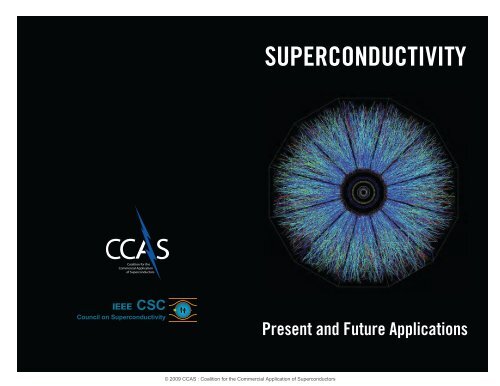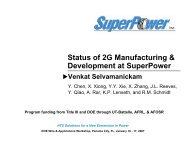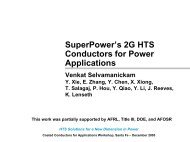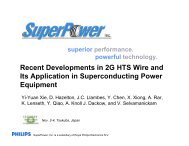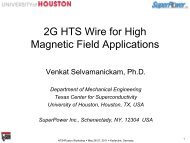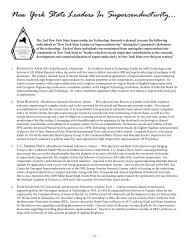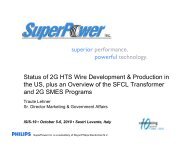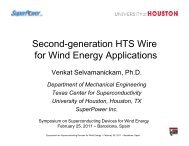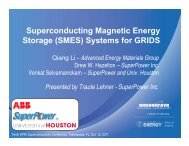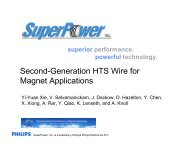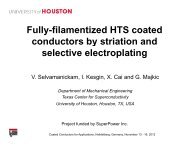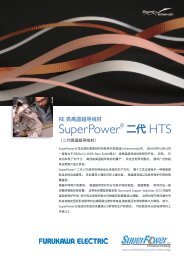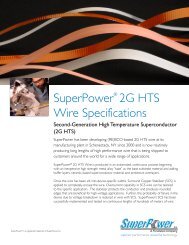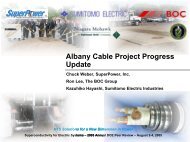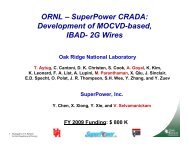superconductivity - CCAS - Coalition for the Commercial Application ...
superconductivity - CCAS - Coalition for the Commercial Application ...
superconductivity - CCAS - Coalition for the Commercial Application ...
You also want an ePaper? Increase the reach of your titles
YUMPU automatically turns print PDFs into web optimized ePapers that Google loves.
SUPERCONDUCTIVITY<br />
CSC<br />
Council on Superconductivity<br />
✕<br />
✖<br />
Present and Future <strong>Application</strong>s<br />
© 2009 <strong>CCAS</strong> : <strong>Coalition</strong> <strong>for</strong> <strong>the</strong> <strong>Commercial</strong> <strong>Application</strong> of Superconductors
CC S<br />
<strong>Coalition</strong> <strong>for</strong> <strong>the</strong><br />
Commerical <strong>Application</strong><br />
of Superconductors<br />
<strong>Coalition</strong> <strong>for</strong> <strong>the</strong> <strong>Commercial</strong> <strong>Application</strong> of Superconductors (<strong>CCAS</strong>)<br />
<strong>CCAS</strong> is a member-driven, non-profit 501(c)6 organization, initially <strong>for</strong>med in 1987 to represent<br />
<strong>superconductivity</strong> stakeholders in <strong>the</strong> United States.<br />
<strong>CCAS</strong> Vision<br />
<strong>CCAS</strong> members believe that <strong>the</strong> commercialization of superconductors and related technologies will translate<br />
into significant benefits to <strong>the</strong> world economies across a broad range of endeavors. Superconductors offer <strong>the</strong><br />
promise of important major advances in efficiency and per<strong>for</strong>mance in electric power generation, transmission<br />
and storage; medical instrumentation; wireless communications; computing; and transportation, that will result<br />
in societal advances that are cost effective and environmentally friendly.<br />
<strong>CCAS</strong> Mission<br />
The mission of <strong>CCAS</strong> is to provide broad dissemination of <strong>the</strong> applications and benefits of <strong>superconductivity</strong> and<br />
related technologies and to represent <strong>the</strong> industry by speaking with a united voice on public policy issues.<br />
<strong>CCAS</strong> seeks to ensure that <strong>the</strong> societal and economic benefits of superconductors are effectively realized and<br />
speedily implemented by endorsing and supporting government programs and activities consistent with <strong>the</strong><br />
<strong>CCAS</strong> vision.<br />
<strong>CCAS</strong> seeks to enable members to communicate and collaborate, nationally and internationally, to collectively<br />
develop and demonstrate multi-disciplinary technology, to educate policy makers, and to advocate priorities<br />
<strong>for</strong> adequate government funding <strong>for</strong> superconductor based programs from research to pre-commercial<br />
demonstrations.<br />
<strong>CCAS</strong> Membership<br />
<strong>CCAS</strong> is a U.S. based organization with membership open to all stakeholders that share an interest in its<br />
vision and mission. <strong>CCAS</strong> members are involved in <strong>the</strong> end-use, manufacture, development and research<br />
of superconductor based systems, products and related technologies. Members comprise large and small<br />
corporations, research institutions, national laboratories and universities.<br />
For more in<strong>for</strong>mation contact Dr. Alan Lauder, Executive Director, <strong>CCAS</strong>, at alauder@comcast.net or by phone<br />
at 610-388-6901.<br />
CSC<br />
Council on Superconductivity<br />
IEEE Council on Superconductivity (IEEE CSC)<br />
The IEEE Council on Superconductivity promotes activities that cover <strong>the</strong> science and technology of<br />
superconductors and <strong>the</strong>ir applications. Areas of interest range from small scale applications, such as ultrasensitive<br />
radiation detectors and sensors, and analog and digital circuits and systems, to large scale applications<br />
such as high field magnets, and electrical power generation, storage and transmission. The development and<br />
enhancement of <strong>the</strong> properties of superconductor materials suitable <strong>for</strong> use with <strong>the</strong>se applications is also of<br />
great interest.<br />
The IEEE CSC distributes technical in<strong>for</strong>mation mainly through its publication of <strong>the</strong> IEEE Transactions on<br />
Applied Superconductivity.<br />
The purpose of <strong>the</strong> Council is to advance and coordinate work in <strong>the</strong> field of <strong>superconductivity</strong> conducted<br />
throughout <strong>the</strong> IEEE, and as such is primarily technical and educational in character. To fur<strong>the</strong>r <strong>the</strong>se<br />
objectives, <strong>the</strong> Council may publish appropriate periodicals, sponsor IEEE <strong>superconductivity</strong> related conferences<br />
and conference sessions, sponsor IEEE Press publications, and engage in any o<strong>the</strong>r activity within its field of<br />
interest that is consistent with <strong>the</strong> Constitution, Bylaws, and Policies of <strong>the</strong> IEEE, and of <strong>the</strong> IEEE Council on<br />
Superconductivity.<br />
Member Groups and Societies<br />
IEEE Member Societies of <strong>the</strong> Council include <strong>the</strong> Communications Society, Components, Packaging and<br />
Manufacturing Society, Dielectrics and Electrical Insulation Society, Electron Devices Society, Instrumentation<br />
and Measurement Society, Magnetics Society, Microwave Theory and Techniques Society, Power Engineering<br />
Society, Reliability Society, and <strong>the</strong> Ultrasonics, Ferroelectrics and Frequency Control Society.<br />
Awards<br />
IEEE CSC has established two awards, approved by <strong>the</strong> IEEE, to recognize researchers, engineers and<br />
managers, who during <strong>the</strong>ir professional careers have made outstanding contributions to <strong>the</strong> field of applied<br />
<strong>superconductivity</strong>. Awardees receive a plaque, an inscribed medallion, and a cash honorarium. For in<strong>for</strong>mation,<br />
contact Dr. Martin Nisenoff at .<br />
The IEEE Award <strong>for</strong> Continuing and Significant Contributions in <strong>the</strong> Field of Applied Superconductivity<br />
recognizes individuals <strong>for</strong> contributions in <strong>the</strong> field of applied <strong>superconductivity</strong> over a period of time based<br />
on novel and innovative concepts proposed by <strong>the</strong> individual, <strong>the</strong> authorship or co-authorship of a number<br />
of publications of major significance to <strong>the</strong> field of applied <strong>superconductivity</strong> and <strong>the</strong> presentation of a<br />
number of invited and plenary talks at major national and international conferences and meetings in applied<br />
<strong>superconductivity</strong>.<br />
The IEEE Max Swerdlow Award <strong>for</strong> Sustained Service to <strong>the</strong> Applied Superconductivity Community<br />
recognizes sustained service to <strong>the</strong> applied <strong>superconductivity</strong> community that has had a lasting influence on <strong>the</strong><br />
advancement of <strong>the</strong> technology ei<strong>the</strong>r through <strong>the</strong> demonstration of exceptional service to and leadership within<br />
<strong>the</strong> community, <strong>the</strong> promotion of major programs in applied <strong>superconductivity</strong> or through management roles in<br />
major research organizations.<br />
✕<br />
✖<br />
Distinguished Lecturers<br />
For in<strong>for</strong>mation about <strong>the</strong> current Distinguished Lecturer or to nominate someone to be a future Lecturer, please<br />
contact Dr. John Spargo, President, IEEE CSC, at .<br />
© 2009 <strong>CCAS</strong> : <strong>Coalition</strong> <strong>for</strong> <strong>the</strong> <strong>Commercial</strong> <strong>Application</strong> of Superconductors
Superconductivity<br />
Present and Future <strong>Application</strong>s<br />
Properties, History, <strong>Application</strong>s and Challenges 2<br />
An Overview of <strong>Application</strong>s 4<br />
<strong>Application</strong>s in Electric Power 6<br />
<strong>Application</strong>s in Transportation 11<br />
<strong>Application</strong>s in Medical Imaging and Diagnostics 15<br />
<strong>Application</strong>s in NMR 20<br />
<strong>Application</strong>s in Industrial Processing 22<br />
<strong>Application</strong>s in High Energy Physics 24<br />
<strong>Application</strong>s in Wireless Communications 26<br />
<strong>Application</strong>s in Instrumentation, Sensors, Standards and Radar 28<br />
<strong>Application</strong>s in High-End Computing 30<br />
Cryogenics: The Enabling Technology 32<br />
© 2008 <strong>CCAS</strong> / IEEE CSC Outreach<br />
For brochure reprints contact: alauder@comcast.net<br />
© 2009 <strong>CCAS</strong> : <strong>Coalition</strong> <strong>for</strong> <strong>the</strong> <strong>Commercial</strong> <strong>Application</strong> of Superconductors
Superconductivity: Present and Future <strong>Application</strong>s<br />
Superconductivity: Properties, History, <strong>Application</strong>s and<br />
Challenges<br />
Superconductors differ fundamentally in quantum physics behavior<br />
from conventional materials in <strong>the</strong> manner by which electrons, or<br />
electric currents, move through <strong>the</strong> material. It is <strong>the</strong>se differences<br />
that give rise to <strong>the</strong> unique properties and per<strong>for</strong>mance benefits that<br />
differentiate superconductors from all o<strong>the</strong>r known conductors.<br />
Unique Properties<br />
• Zero resistance to direct current<br />
• Extremely high current carrying density<br />
• Extremely low resistance at high frequencies<br />
• Extremely low signal dispersion<br />
• High sensitivity to magnetic field<br />
• Exclusion of externally applied magnetic field<br />
• Rapid single flux quantum transfer<br />
• Close to speed of light signal transmission<br />
2<br />
Zero resistance and high current density have a major impact on electric power<br />
transmission and also enable much smaller or more powerful magnets <strong>for</strong> motors,<br />
generators, energy storage, medical equipment and industrial separations. Low<br />
resistance at high frequencies and extremely low signal dispersion are key aspects<br />
in microwave components, communications technology and several military<br />
applications. Low resistance at higher frequencies also reduces substantially <strong>the</strong><br />
challenges inherent to miniaturization brought about by resistive, or I 2 R, heating.<br />
The high sensitivity of superconductors to magnetic field provides a unique sensing<br />
capability, in many cases 1000x superior to today’s best conventional measurement<br />
technology. Magnetic field exclusion is important in multi-layer electronic<br />
component miniaturization, provides a mechanism <strong>for</strong> magnetic levitation and<br />
enables magnetic field containment of charged particles. The final two properties<br />
<strong>for</strong>m <strong>the</strong> basis <strong>for</strong> digital electronics and high speed computing well beyond <strong>the</strong><br />
<strong>the</strong>oretical limits projected <strong>for</strong> semiconductors. All of <strong>the</strong>se materials properties<br />
have been extensively demonstrated throughout <strong>the</strong> world.<br />
History of Superconductor Materials<br />
In 1911, H. K. Onnes, a Dutch physicist, discovered <strong>superconductivity</strong> by cooling<br />
mercury metal to extremely low temperature and observing that <strong>the</strong> metal exhibited<br />
zero resistance to electric current. Prior to 1973 many o<strong>the</strong>r metals and metal<br />
alloys were found to be superconductors at temperatures below 23.2K. These<br />
became known as Low Temperature Superconductor (LTS) materials. Since<br />
<strong>the</strong> 1960s a Niobium-Titanium (Ni-Ti) alloy has been <strong>the</strong> material of choice <strong>for</strong><br />
commercial superconducting magnets. More recently, a brittle Niobium-Tin<br />
intermetallic material has emerged as an excellent alternative to achieve even<br />
higher magnetic field strength. In 1986, J. G. Bednorz and K. A. Müller discovered<br />
© 2009 <strong>CCAS</strong> : <strong>Coalition</strong> <strong>for</strong> <strong>the</strong> <strong>Commercial</strong> <strong>Application</strong> of Superconductors
Superconductivity: Present and Future <strong>Application</strong>s<br />
oxide based ceramic materials that demonstrated superconducting properties as<br />
high as 35K. This was quickly followed in early 1997 by <strong>the</strong> announcement by C.<br />
W. Chu of a cuprate superconductor functioning above 77K, <strong>the</strong> boiling point of<br />
liquid nitrogen. Since <strong>the</strong>n, extensive research worldwide has uncovered many<br />
more oxide based superconductors with potential manufacturability benefits and<br />
critical temperatures as high as 135K. A superconducting material with a critical<br />
temperature above 23.2K is known as a High Temperature Superconductor (HTS),<br />
despite <strong>the</strong> continuing need <strong>for</strong> cryogenic refrigeration <strong>for</strong> any application.<br />
3<br />
Image courtesy of Department of Energy - Basic Energy Sciences<br />
Challenges<br />
• Cost<br />
• Refrigeration<br />
• Reliability<br />
• Acceptance<br />
Forty years of development and commercialization of applications involving<br />
LTS materials have demonstrated that a superconductor approach works best<br />
when it represents a unique solution to <strong>the</strong> need. Alternatively, as <strong>the</strong> cost of <strong>the</strong><br />
superconductor will always be substantially higher than that of a conventional<br />
conductor, it must bring overwhelming cost effectiveness to <strong>the</strong> system. The<br />
advent of HTS has changed <strong>the</strong> dynamic of refrigeration by permitting smaller<br />
and more efficient system cooling <strong>for</strong> some applications. Design, integration<br />
of superconducting and cryogenic technologies, demonstration of systems cost<br />
benefits and long term reliability must be met be<strong>for</strong>e <strong>superconductivity</strong> delivers on<br />
its current promise of major societal benefits and makes substantial commercial<br />
inroads into new applications.<br />
© 2009 <strong>CCAS</strong> : <strong>Coalition</strong> <strong>for</strong> <strong>the</strong> <strong>Commercial</strong> <strong>Application</strong> of Superconductors
Superconductivity: Present and Future <strong>Application</strong>s<br />
Superconductivity: An Overview of <strong>Application</strong>s<br />
Superconductivity is a unique and powerful phenomenon of nature.<br />
Nearly a century after its first discovery, its full commercial potential is<br />
just beginning to be exploited.<br />
About Superconductivity<br />
Superconductivity is widely regarded as one of <strong>the</strong> great scientific discoveries<br />
of <strong>the</strong> 20th Century. This miraculous property causes certain materials, at<br />
low temperatures, to lose all resistance to <strong>the</strong> flow of electricity. This state of<br />
“losslessness” enables a range of innovative technology applications. At <strong>the</strong> dawn<br />
of <strong>the</strong> 21st century, <strong>superconductivity</strong> <strong>for</strong>ms <strong>the</strong> basis <strong>for</strong> new commercial products<br />
that are trans<strong>for</strong>ming our economy and daily life.<br />
Current <strong>Commercial</strong> <strong>Application</strong>s<br />
• Magnetic Resonance Imaging (MRI)<br />
• Nuclear Magnetic Resonance (NMR)<br />
• High-energy physics accelerators<br />
• Plasma fusion reactors<br />
• Industrial magnetic separation of kaolin clay<br />
4<br />
The major commercial applications of <strong>superconductivity</strong> in <strong>the</strong> medical diagnostic,<br />
science and industrial processing fields listed above all involve LTS materials and<br />
relatively high field magnets. Indeed, without superconducting technology most of<br />
<strong>the</strong>se applications would not be viable. Several smaller applications utilizing LTS<br />
materials have also been commercialized, e.g. research magnets and Magneto-<br />
Encephalograhy (MEG). The latter is based on Superconducting Quantum<br />
Interference Device (SQUID) technology which detects and measures <strong>the</strong> weak<br />
magnetic fields generated by <strong>the</strong> brain. The only substantive commercial products<br />
incorporating HTS materials are electronic filters used in wireless base stations.<br />
About 10,000 units have been installed in wireless networks worldwide to date.<br />
More detail on <strong>the</strong>se applications is presented in subsequent sections.<br />
Emerging <strong>Application</strong>s<br />
Superconductor-based products are extremely environmentally friendly compared<br />
to <strong>the</strong>ir conventional counterparts. They generate no greenhouse gases and<br />
are cooled by non-flammable liquid nitrogen (nitrogen comprises 80% of our<br />
atmosphere) as opposed to conventional oil coolants that are both flammable<br />
and toxic. They are also typically at least 50% smaller and lighter than equivalent<br />
conventional units which translates into economic incentives. These benefits have<br />
given rise to <strong>the</strong> ongoing development of many new applications in <strong>the</strong> following<br />
sectors:<br />
Electric Power. Superconductors enable a variety of applications to aid our aging<br />
and heavily burdened electric power infrastructure - <strong>for</strong> example, in generators,<br />
trans<strong>for</strong>mers, underground cables, synchronous condensers and fault current<br />
© 2009 <strong>CCAS</strong> : <strong>Coalition</strong> <strong>for</strong> <strong>the</strong> <strong>Commercial</strong> <strong>Application</strong> of Superconductors
Superconductivity: Present and Future <strong>Application</strong>s<br />
limiters. The high power density and electrical efficiency of superconductor wire<br />
results in highly compact, powerful devices and systems that are more reliable,<br />
efficient, and environmentally benign.<br />
Transportation. The rapid and efficient movement of people and goods,<br />
by land and by sea, poses important logistical, environmental, land use and<br />
o<strong>the</strong>r challenges. Superconductors are enabling a new generation of transport<br />
technologies including ship propulsion systems, magnetically levitated trains, and<br />
railway traction trans<strong>for</strong>mers.<br />
Medicine. Advances in HTS promise more compact and less costly Magnetic<br />
Resonance Imaging (MRI) systems with superior imaging capabilities. In addition,<br />
Magneto-Encephalography (MEG), Magnetic Source Imaging (MSI) and Magneto-<br />
Cardiology (MCG) enable non-invasive diagnosis of brain and heart functionality.<br />
Industry. Large motors rated at 1000 HP and above consume 25% of all electricity<br />
generated in <strong>the</strong> United States. They offer a prime target <strong>for</strong> <strong>the</strong> use of HTS in<br />
substantially reducing electrical losses. Powerful magnets <strong>for</strong> water remediation,<br />
materials purification, and industrial processing are also in <strong>the</strong> demonstration<br />
stages.<br />
Communications. Over <strong>the</strong> past decade, HTS filters have come into widespread<br />
use in cellular communications systems. They enhance signal-to-noise ratios,<br />
enabling reliable service with fewer, more widely-spaced cell towers. As <strong>the</strong><br />
world moves from analog to all digital communications, LTS chips offer dramatic<br />
per<strong>for</strong>mance improvements in many commercial and military applications.<br />
Scientific Research. Using superconducting materials, today’s leading-edge<br />
scientific research facilities are pushing <strong>the</strong> frontiers of human knowledge - and<br />
pursuing breakthroughs that could lead to new techniques ranging from <strong>the</strong> clean,<br />
abundant energy from nuclear fusion to computing at speeds much faster than <strong>the</strong><br />
<strong>the</strong>oretical limit of silicon technology.<br />
Issues and Recommendations<br />
Recent progress in <strong>superconductivity</strong> follows a pattern that marked previous<br />
developments in new materials - <strong>for</strong> example, in transistors, semiconductors<br />
and optical fibers. Materials-based technology development entails high risk and<br />
uncertainty compared to more incremental innovations. It typically takes 20 years<br />
to move new materials from <strong>the</strong> laboratory to <strong>the</strong> commercial arena. Yet products<br />
using new materials often yield <strong>the</strong> most dramatic benefits <strong>for</strong> society in <strong>the</strong> long<br />
run.<br />
The long lead times inherent in HTS technology development necessitates a<br />
sustained government role, and government-industry partnerships play a pivotal<br />
role in this process. These partnerships require stable and consistent funding and<br />
a tolerance <strong>for</strong> risk. Careful planning is required to ensure parallel progress in<br />
related fields, such as cryogenics, to assure broad commercial acceptance of new<br />
LTS and of HTS technology. Prospective customers such as electric utilities require<br />
a stable and symmetrical climate <strong>for</strong> investment in research, development and<br />
demonstration projects.<br />
5<br />
© 2009 <strong>CCAS</strong> : <strong>Coalition</strong> <strong>for</strong> <strong>the</strong> <strong>Commercial</strong> <strong>Application</strong> of Superconductors
Superconductivity: Present and Future <strong>Application</strong>s<br />
Superconductivity: <strong>Application</strong>s in Electric Power<br />
Today’s power grid operators face complex challenges that threaten<br />
<strong>the</strong>ir ability to provide reliable service: steady demand growth; aging<br />
infrastructure; mounting obstacles to siting new plants and lines; and<br />
new uncertainties brought on by structural and regulatory re<strong>for</strong>ms.<br />
Advances in high temperature <strong>superconductivity</strong> (HTS) over <strong>the</strong> past<br />
two decades are yielding a new set of technology tools to renew this<br />
critical infrastructure, and to enhance <strong>the</strong> capacity, reliability and<br />
efficiency, of <strong>the</strong> nation’s power system.<br />
6<br />
The US Power Grid Under Stress<br />
Power industry experts in <strong>the</strong> United States are widely agreed that today’s<br />
aging power grid must be streng<strong>the</strong>ned and modernized. Utilities must cope<br />
with a growth in <strong>the</strong> underlying level of demand driven by our expanding,<br />
high technology-intensive economy. Consumers in <strong>the</strong> digital age have rising<br />
expectations and requirements <strong>for</strong> grid reliability and power quality. Competitive<br />
re<strong>for</strong>ms have brought about new patterns of power flows. EPRI (<strong>the</strong> Electric Power<br />
Research Institute) has estimated that $100 billion must be spent over <strong>the</strong> next ten<br />
years to achieve and maintain acceptable levels of electric reliability.<br />
At <strong>the</strong> same time, utility shareholders are insisting on strong financial<br />
per<strong>for</strong>mance and more intensive use of existing utility assets. Moreover, gaining<br />
approval to site new infrastructure - both generating plants as well as transmission<br />
lines - has become extremely difficult in <strong>the</strong> face of landowner and community<br />
opposition and <strong>the</strong> NIMBY (“not in my back yard”) phenomenon. This is<br />
especially <strong>the</strong> case in urbanized areas where power needs<br />
are concentrated. As a result, utilities face lengthy and<br />
uncertain planning horizons, as well as a rising risk of<br />
costly blackouts and o<strong>the</strong>r reliability problems.<br />
The existing grid is also becoming increasingly<br />
regionalized with more generation located remotely to<br />
be close to its particular source of fuel. The grid will<br />
<strong>the</strong>re<strong>for</strong>e have to mitigate increasing inter-regional fault<br />
current transfers and <strong>the</strong> increasing number of parallel<br />
transmission paths that will be required to allow lowest<br />
cost electricity to flow to where it is needed and to allow a<br />
smarter grid to quickly respond to disruptions of sources,<br />
transmission or local generation paths. Distributed<br />
generation can help but is not always available when<br />
needed, and also must be redesigned, possibly with <strong>the</strong><br />
help of fault current limiters, to ride through local faults<br />
and remain available.<br />
HTS power cable<br />
Image courtesy of Sumitomo Electric /<br />
SuperPower<br />
Solving this complex set of problems will require a<br />
combination of new policies and technologies. Regulatory<br />
re<strong>for</strong>ms are needed to foster stronger incentives <strong>for</strong> grid<br />
© 2009 <strong>CCAS</strong> : <strong>Coalition</strong> <strong>for</strong> <strong>the</strong> <strong>Commercial</strong> <strong>Application</strong> of Superconductors
Superconductivity: Present and Future <strong>Application</strong>s<br />
investment and to overcome <strong>the</strong> fragmentation that has impeded utilities’ ability<br />
to raise <strong>the</strong> required investment capital. Beyond new rules, however, <strong>the</strong> physical<br />
nature of <strong>the</strong> challenge requires <strong>the</strong> adoption of advanced grid technologies,<br />
including those based on HTS.<br />
These new HTS technologies have undergone rapid development in <strong>the</strong><br />
comparatively short time of two decades. The first HTS compounds were<br />
syn<strong>the</strong>sized in research laboratories in <strong>the</strong> late 1980s. Today, <strong>the</strong> HTS industry has<br />
advanced to full-scale power equipment prototypes and demonstration projects<br />
that are undergoing <strong>the</strong> rigors of in-grid evaluation. As <strong>the</strong>se new technologies are<br />
incorporated into <strong>the</strong> existing power system, <strong>the</strong>y will offer utilities new tools to<br />
ease <strong>the</strong> pressures that limit <strong>the</strong> per<strong>for</strong>mance and capacity of <strong>the</strong>ir systems - with<br />
much lower space and land use impacts and with major environmental benefits<br />
than are available using traditional grid upgrade solutions.<br />
HTS Wire. The foundation of <strong>the</strong>se applications is a new generation of wire,<br />
capable of carrying vastly (on <strong>the</strong> order of 100+ times) higher currents than<br />
conventional copper wires of <strong>the</strong> same dimension, with zero or negligible resistive<br />
losses. Today’s prototype and demonstration technologies have made use of a<br />
proven, readily available and high-per<strong>for</strong>mance first generation HTS wire that<br />
is multifilamentary in composition. Second generation (2G) HTS wire, using a<br />
coated conductor architecture and a variety of thin film manufacturing processes,<br />
is rapidly making its way to market. 2G wire will greatly broaden <strong>the</strong> addressable<br />
market <strong>for</strong> existing HTS devices because of its predicted lower cost. It will also<br />
enable altoge<strong>the</strong>r new types of HTS applications due to its superior per<strong>for</strong>mance<br />
characteristics in certain modes of operation. 2G wire has been commercially<br />
available since 2006.<br />
HTS wire, in short, brings <strong>the</strong> promise of a revolution in <strong>the</strong> way electricity is<br />
generated, delivered and consumed - much as <strong>the</strong> introduction of optical fiber led<br />
to a technological leap <strong>for</strong>ward in <strong>the</strong> telecommunications industry. Among <strong>the</strong><br />
power applications HTS wire enables are <strong>the</strong> following:<br />
HTS Power Cables. Today’s conventional power lines and cables are being<br />
operated closer to <strong>the</strong>ir <strong>the</strong>rmal limits, and new lines are becoming hard to site.<br />
Compact, high-capacity underground HTS cables offer an important new tool <strong>for</strong><br />
boosting grid capacity. Today’s<br />
advanced HTS cable designs enable<br />
controllable power flows and <strong>the</strong><br />
complete suppression of stray EMF.<br />
HTS power cables transmit 3-5<br />
times more power than conventional<br />
copper cables of equivalent cross<br />
section, enabling more effective use<br />
of limited and costly rights-of-way.<br />
Significant progress toward <strong>the</strong><br />
commercialization of HTS cable<br />
is underway. Three major in-grid<br />
138kV HTS cable system installed in Long Island, NY<br />
Image courtesy of American Superconductor<br />
7<br />
© 2009 <strong>CCAS</strong> : <strong>Coalition</strong> <strong>for</strong> <strong>the</strong> <strong>Commercial</strong> <strong>Application</strong> of Superconductors
Superconductivity: Present and Future <strong>Application</strong>s<br />
8<br />
demonstrations have been completed in <strong>the</strong> US including <strong>the</strong> world’s first HTS<br />
power transmission cable system in a commercial power grid which is capable of<br />
transmitting up to 574 megawatts (MW) of electricity, enough to power 300,000<br />
homes. Two more demonstrations are in <strong>the</strong> planning stage in <strong>the</strong> US and ano<strong>the</strong>r<br />
dozen projects are active around <strong>the</strong> world.<br />
HTS Fault Current Limiters. As new generators<br />
are added to <strong>the</strong> network, many local grids<br />
face a rising risk of unacceptably high power<br />
surges that result from “faults” or short circuits.<br />
These occasional surges are induced by adverse<br />
wea<strong>the</strong>r, falling tree limbs, traffic accidents,<br />
animal interference and o<strong>the</strong>r random events.<br />
As fault current levels rise, <strong>the</strong>y pose a mounting<br />
risk that such surges will exceed <strong>the</strong> rating of<br />
Fault Current Limiter<br />
Image Courtesy of Zenergy Power<br />
existing conventional circuit breakers, switchgear,<br />
bus, distribution trans<strong>for</strong>mers and o<strong>the</strong>r equipment<br />
and expose grids to much more costly damage. HTS technology enables a new<br />
solution: compact, “smart” fault current limiters (FCLs) that operate, passively<br />
and automatically, as power “safety valves” to ensure system reliability when<br />
individual circuits are disrupted. Taking advantage of <strong>the</strong> inherent properties of<br />
superconductors, <strong>the</strong>y sense such dangerous overcurrents and reduce <strong>the</strong>m to safe<br />
levels by changing state instantaneously, from from “super” conductors to resistors.<br />
Several demonstrations of this breakthrough technology are now underway, with an<br />
expected commercial horizon of 2010.<br />
HTS Trans<strong>for</strong>mers <strong>for</strong> <strong>the</strong> Grid. Grid operators face a major challenge in<br />
moving power safely and efficiently, from generators to consumers, through<br />
several stages of voltage trans<strong>for</strong>mation. At each stage, valuable energy is lost in<br />
<strong>the</strong> <strong>for</strong>m of waste heat. Moreover, while demands are continually rising, space <strong>for</strong><br />
trans<strong>for</strong>mers and substations - especially in dense urban areas - is severely limited.<br />
Conventional oil-cooled trans<strong>for</strong>mers also pose a fire and environmental hazard.<br />
Compact, efficient HTS trans<strong>for</strong>mers, by contrast, are cooled by safe, abundant<br />
and environmentally benign liquid nitrogen. As an additional benefit, <strong>the</strong>se<br />
actively-cooled devices will offer <strong>the</strong> capability of operating in overload, to twice<br />
<strong>the</strong> nameplate rating, without any loss of life to meet occasional utility peak load<br />
demands.<br />
HTS Trans<strong>for</strong>mers <strong>for</strong> Wind Energy.<br />
The increasing demand <strong>for</strong> clean, carbonfree<br />
electric power, coupled with <strong>the</strong> global<br />
warming crisis, has fueled tremendous<br />
interest in and development of renewable<br />
energy technologies such as wind power.<br />
To break through <strong>the</strong> economic barrier<br />
and assure <strong>the</strong> future of this vast and<br />
critically important green energy source, new<br />
Wind turbine<br />
Image courtesy of American Superconductor<br />
© 2009 <strong>CCAS</strong> : <strong>Coalition</strong> <strong>for</strong> <strong>the</strong> <strong>Commercial</strong> <strong>Application</strong> of Superconductors
Superconductivity: Present and Future <strong>Application</strong>s<br />
technologies are needed offering lower weight, higher efficiency, and significantly<br />
improved reliability. Direct drive wind generators are utilizing a new high-efficiency<br />
stator design and replacing copper with HTS wire on <strong>the</strong> rotor. Estimates are that<br />
a 10 MW drive utilizing HTS technology would weigh about one third <strong>the</strong> weight of<br />
a conventional direct drive generator with <strong>the</strong> same power rating. This reduction<br />
in weight would also allow an increase in blade size and greater power output. The<br />
net effect is expected to double <strong>the</strong> power capacity of conventional systems and<br />
lower <strong>the</strong> cost of wind generated energy.<br />
Energy Storage. With power lines increasingly congested and prone to<br />
instability, strategic injection of brief bursts of real power can play a crucial role in<br />
maintaining grid reliability. Small-scale Superconducting Magnetic Energy Storage<br />
(SMES) systems, based on low-temperature superconductor, have been in use<br />
<strong>for</strong> many years. These have been applied to enhance <strong>the</strong> capacity and reliability<br />
of stability-constrained utility grids, as well as by large industrial user sites with<br />
sensitive, high-speed processes, to improve reliability and power quality. Larger<br />
systems, and systems employing HTS, are a focus of development. Flywheels, based<br />
on frictionless superconductor bearings, can trans<strong>for</strong>m electric energy into kinetic<br />
energy, store <strong>the</strong> energy in a rotating flywheel, and use <strong>the</strong> rotational kinetic energy<br />
to regenerate electricity as needed. Using bulk HTS self centering bearings allows<br />
levitation and rotation in a vacuum, <strong>the</strong>reby reducing friction losses. Conventional<br />
flywheels suffer energy losses of 3-5% per hour, whereas HTS based flywheels<br />
operate at
Superconductivity: Present and Future <strong>Application</strong>s<br />
10<br />
“breaking <strong>the</strong> gridlock” of power flows and policy re<strong>for</strong>ms that threaten <strong>the</strong> power<br />
industry and our overall economy.<br />
However, be<strong>for</strong>e HTS technology solutions can enjoy broad acceptance, <strong>the</strong>y<br />
must undergo field trials. Such demonstrations play a crucial role in establishing<br />
a record of reliability and working out grid integration issues. Despite <strong>the</strong> acute<br />
needs facing <strong>the</strong> electricity sectors, it is widely observed that investor-owned utilities<br />
have taken a cautious and conservative approach to adopting new technology<br />
solutions in recent years. This has resulted from several factors including: a<br />
perception of asymmetric regulatory risks; disallowances resulting from past<br />
technology failures; and <strong>the</strong> loss of sites where experimental technologies can<br />
be tested without potentially adverse consequences <strong>for</strong> customers. Industry<br />
restructuring ef<strong>for</strong>ts underway since <strong>the</strong> early 1990’s, moreover, have had <strong>the</strong><br />
un<strong>for</strong>tunate effect of undermining investment in jointly-funded industry R&D.<br />
There is an urgent need to reverse this trend. Government bodies - including<br />
legislatures, regulatory commissions and research-oriented agencies - can foster<br />
a more positive climate <strong>for</strong> HTS “early adopters.” Comprehensive field trials of<br />
<strong>the</strong>se advanced technologies require, by <strong>the</strong>ir nature, stable funding on a multi-year<br />
basis. There are several specific measures that government bodies can undertake<br />
to support <strong>the</strong> more rapid commercialization of <strong>the</strong>se and o<strong>the</strong>r promising grid<br />
technologies:<br />
• Encouragement of additional demonstration and pilot projects of advanced<br />
grid technologies.<br />
• More favorable rate treatment <strong>for</strong> grid-related research and development<br />
expenditures, which have undergone a steep decline since <strong>the</strong> early 1990s.<br />
• More thorough review of all feasible alternatives in <strong>the</strong> regional planning<br />
process - including low-impact grid upgrades along with o<strong>the</strong>r conventional<br />
and non-conventional solutions.<br />
• Review of <strong>the</strong> criteria governing <strong>the</strong> use of “clean energy funds” and o<strong>the</strong>r<br />
state mechanisms to promote new technology development and deployment.<br />
For many emerging technologies, <strong>the</strong> “missing link” to market acceptance is a<br />
reliable pathway to market that could be provided or enhanced by innovative<br />
grid technologies enabled by HTS.<br />
© 2009 <strong>CCAS</strong> : <strong>Coalition</strong> <strong>for</strong> <strong>the</strong> <strong>Commercial</strong> <strong>Application</strong> of Superconductors
Superconductivity: <strong>Application</strong>s in Transportation<br />
Superconductivity: Present and Future <strong>Application</strong>s<br />
Around <strong>the</strong> world, transportation systems of all kinds are facing<br />
unprecedented new challenges. Pressures on <strong>the</strong> systems and<br />
technologies that move people and goods are expected to intensify due<br />
to several factors: rising demand; changes in fuels market economics;<br />
and <strong>the</strong> demand <strong>for</strong> improved system per<strong>for</strong>mance. In response, several<br />
types of transportation are being electrified. Superconductivity can<br />
leverage <strong>the</strong> advantages of electrified transportation of various types,<br />
ranging from high-speed trains to advanced ship propulsion systems.<br />
The incorporation of superconductor technology into transportation<br />
system design can improve <strong>the</strong> efficiency and per<strong>for</strong>mance, reduce <strong>the</strong><br />
weight and fuel consumption, and extend <strong>the</strong> range of transportation<br />
systems of all types.<br />
Transportation at a Crossroads<br />
Around <strong>the</strong> world, today’s transportation systems are facing an unfolding crisis.<br />
Nearly all of <strong>the</strong> dominant technologies that provide mobility today - including<br />
automobiles, trains, ships and aircraft - depend overwhelmingly on petroleumbased<br />
fuels. Yet world oil prices continue to rise, and low-cost oil supplies are<br />
dwindling. Modern societies, which depend on a high level of mobility, face <strong>the</strong><br />
prospect of higher costs and concomitant slower economic growth if new solutions<br />
to assure <strong>the</strong> movement of passengers and goods are not available.<br />
One of <strong>the</strong> most promising responses to this challenge lies in <strong>the</strong> electrification<br />
of transportation. Electrification allows <strong>for</strong> <strong>the</strong> powering of many transportation<br />
systems from <strong>the</strong> interconnected power grid and <strong>the</strong> inherent efficiency of electric<br />
drive systems can also result in significant cost savings.<br />
In many ways, <strong>the</strong> electrification of transportation is an old story. In <strong>the</strong> late<br />
19th century, electric streetcar<br />
systems literally provided <strong>the</strong><br />
incentive to electrify urban<br />
neighborhoods. Through <strong>the</strong><br />
mid-20th century, many developed<br />
nations adopted high-speed<br />
electric trains. However, <strong>the</strong> rise<br />
of low-cost oil in <strong>the</strong> early 20th<br />
century encouraged <strong>the</strong> migration<br />
away from grid-based systems to<br />
<strong>the</strong> adoption of alternatives that offered greater convenience and flexibility.<br />
In <strong>the</strong> 21st century, electricity is getting a new look as <strong>the</strong> basis <strong>for</strong><br />
powering transportation systems. Factors driving interest in electrification of<br />
transportation include both <strong>the</strong> per<strong>for</strong>mance advantages of electric systems<br />
as well as <strong>the</strong> increasing cost and tightening supply of oil. Today’s innovations<br />
are adapting electric technology in ways that combine <strong>the</strong> advantages of standalone<br />
transportation systems with <strong>the</strong> cleanliness, efficiency and convenience<br />
11<br />
© 2009 <strong>CCAS</strong> : <strong>Coalition</strong> <strong>for</strong> <strong>the</strong> <strong>Commercial</strong> <strong>Application</strong> of Superconductors
Superconductivity: Present and Future <strong>Application</strong>s<br />
of electricity. Prominent land-based examples of today’s cutting-edge mobility<br />
innovations include rechargeable, plug-in hybrid cars; super high-speed<br />
magnetically levitated trains; and intercity trains with more efficient traction<br />
trans<strong>for</strong>mers. All of <strong>the</strong>se transportation systems could be powered by a wide range<br />
of energy sources through <strong>the</strong> power grid. Meanwhile, at sea, ship propulsion is<br />
also being electrified, employing self-contained systems <strong>for</strong> <strong>the</strong> efficient production<br />
and delivery of power on board large vessels.<br />
The Role of Superconductivity<br />
Superconductivity offers several ways to leverage <strong>the</strong> benefits of electrification<br />
in many of <strong>the</strong>se transport applications. High-per<strong>for</strong>mance, lightweight<br />
superconductor technologies can make transportation propulsion systems more<br />
powerful yet smaller and lighter. The following capsule descriptions explain how<br />
<strong>superconductivity</strong> is being applied in a variety of transportation technologies to<br />
ensure that society continues to enjoy mobility in a resource-constrained world.<br />
12<br />
HTS Marine Ship Propulsion: A Revolution in Ship Design<br />
Within <strong>the</strong> past 20 years, ship designers have begun to adopt electric propulsion<br />
systems. This shift has been characterized as <strong>the</strong> most important change in ship<br />
design since <strong>the</strong> adoption of diesel engines in <strong>the</strong> 1920s. Electric propulsion<br />
systems enable new, more flexible arrangements and <strong>the</strong> more efficient integration<br />
of a ship’s energy-using systems, because <strong>the</strong>y allow <strong>the</strong> same power plant to<br />
support propulsion as well as o<strong>the</strong>r requirements. As a result, ships can be<br />
redesigned to provide more<br />
space below deck, whe<strong>the</strong>r<br />
<strong>for</strong> passengers, cargo or, in<br />
<strong>the</strong> case of naval applications,<br />
weapons and weapon systems.<br />
Among large commercial ocean<br />
going vessels, nearly 100% of<br />
all new ships are electrically<br />
propelled, including many large<br />
cruise ships such as <strong>the</strong> Queen<br />
Mary 2. Electric propulsion<br />
offers o<strong>the</strong>r advantages <strong>for</strong><br />
naval applications and in 2000,<br />
<strong>the</strong> US Navy announced that it would migrate toward an all-electric fleet.<br />
The large size and heavy weight of conventional copper-based electrical<br />
propulsion motors and generators has been a barrier to broad adoption of electric<br />
propulsion. For <strong>the</strong>se reasons, superconductors offer additional, important<br />
advantages <strong>for</strong> electrically propelled ships. HTS motors and generators are much<br />
smaller and lighter; operating prototypes are one-third <strong>the</strong> size and weight of <strong>the</strong>ir<br />
conventional copper-wound counterparts and quieter. The elimination of rotor<br />
losses results in much higher efficiency, especially under partial-load conditions,<br />
where many ships operate <strong>for</strong> <strong>the</strong> great majority of <strong>the</strong>ir operating hours. This<br />
Cruise Ship<br />
Image courtesy of American Superconductor<br />
© 2009 <strong>CCAS</strong> : <strong>Coalition</strong> <strong>for</strong> <strong>the</strong> <strong>Commercial</strong> <strong>Application</strong> of Superconductors
Superconductivity: Present and Future <strong>Application</strong>s<br />
improved efficiency translates into<br />
a longer cruising range and greater<br />
fuel economy. Smaller motor<br />
assemblies could also enable electric<br />
ships to use shallower ports, and<br />
could be incorporated directly into<br />
steerable pod-based assemblies,<br />
resulting in greater flexibility and<br />
improved maneuverability. Smaller<br />
propulsion motors translates into<br />
naval ships that can carry more<br />
36.5 MW HTS Ship Drive Motor<br />
powerful weapons such as high<br />
Image courtesy of American Superconductor<br />
power combat radars and additional<br />
missiles. These advantages have garnered significant interest from <strong>the</strong> US Navy and<br />
o<strong>the</strong>r navies around <strong>the</strong> world. Apart from naval and cruise ship applications, o<strong>the</strong>r<br />
possible applications include many o<strong>the</strong>r ship types including LNG tankers, product<br />
tankers, ferries, research ships, cable layers and icebreakers.<br />
HTS Degaussing Coils<br />
Ano<strong>the</strong>r new demonstration of HTS capabilities is under way using specially<br />
designed HTS cables to replace <strong>the</strong> copper degaussing coils on military ships. The<br />
advantages of less weight and size, coupled with high current density, make HTS<br />
cables an ideal solution <strong>for</strong> protection of military vessels.<br />
13<br />
Magnetically Levitated Trains<br />
Several countries in Europe<br />
and Asia rely heavily on rail<br />
transport to carry large numbers<br />
of passengers. For longer haul<br />
express routes, rail transportation<br />
has <strong>the</strong> advantage over air travel<br />
as it typically operates from a<br />
transportation hub in <strong>the</strong> city<br />
center. Magnetically levitated<br />
trains, employing superconducting<br />
magnets, offer a way to make trains<br />
literally “fly” to <strong>the</strong>ir destination<br />
by using powerful magnets to<br />
cause <strong>the</strong>m to float above <strong>the</strong>ir<br />
guideway, or track. Magnetically levitated trains have attained top speeds in excess<br />
of 500 kmph. Some transportation experts believe that maglev transportation<br />
could revolutionize transportation in <strong>the</strong> 21st century in much <strong>the</strong> same way that<br />
airplanes revolutionized 20th century transport.<br />
© 2009 <strong>CCAS</strong> : <strong>Coalition</strong> <strong>for</strong> <strong>the</strong> <strong>Commercial</strong> <strong>Application</strong> of Superconductors
Superconductivity: Present and Future <strong>Application</strong>s<br />
Superconductor magnets are essential to this application because of <strong>the</strong>ir<br />
dramatically lighter weight and lower power requirements. At present, maglev<br />
train lines operating in Japan, Germany and China make use of low temperature<br />
superconductor (LTS) technology. However, <strong>the</strong>re is now research underway on <strong>the</strong><br />
application of HTS coils to maglev trains, which could result in lower cooling costs<br />
and higher stability.<br />
O<strong>the</strong>r HTS <strong>Application</strong>s and Ramifications<br />
O<strong>the</strong>r transportation systems could, in time, be powered by systems using<br />
superconductor wire. The focus of <strong>the</strong>se innovations however, is on large, bulk<br />
transport systems ra<strong>the</strong>r than individual passenger automobiles, which are used<br />
intermittently. The wider adoption of plug-in hybrid automobiles would result in<br />
increased total demand on <strong>the</strong> interconnected power grid and it is often noted<br />
that plug-in hybrid cars could provide a load-leveling function and lead to lower<br />
rates and more efficient grid asset utilization. If this concept becomes very<br />
commonplace, it will necessarily lead to an increase in total demand on <strong>the</strong> power<br />
grid, requiring upgrades to <strong>the</strong> general grid infrastructure. In certain locations,<br />
especially dense urban areas, this could necessitate <strong>the</strong> use of superconductorbased<br />
technologies in order to ensure <strong>the</strong> safe, reliable delivery of large amounts<br />
of power into dense urban areas.<br />
14<br />
The Foundation: Advances in HTS Wire<br />
The basis <strong>for</strong> <strong>the</strong> per<strong>for</strong>mance advantages of <strong>the</strong>se transportation technologies<br />
lies in high-per<strong>for</strong>mance superconductor wire. Electric shipboard motors<br />
employing superconductor wire can generate very powerful fields in a small<br />
fraction of <strong>the</strong> volume and weight of copper-wound motors. O<strong>the</strong>rwise, <strong>the</strong>y make<br />
use of conventional, well-understood designs, employing <strong>the</strong> same century’s<br />
worth of developments and refinements that apply to all AC synchronous electric<br />
motors. Maglev trains, likewise, make use of ultracompact, high-field coils that<br />
would be physically impossible to construct, absent <strong>the</strong> miraculous property of<br />
<strong>superconductivity</strong>.<br />
With worldwide supplies of oil under increasing pressure, <strong>the</strong>re is an<br />
urgent need to develop alternative solutions to ensure that economical means<br />
exist to move people and goods in <strong>the</strong> world of tomorrow. The phenomenon of<br />
<strong>superconductivity</strong>, which has found uses in applications ranging from research and<br />
medicine to electric power, could play a critical role in ensuring that <strong>the</strong>se pressing<br />
needs can be met.<br />
© 2009 <strong>CCAS</strong> : <strong>Coalition</strong> <strong>for</strong> <strong>the</strong> <strong>Commercial</strong> <strong>Application</strong> of Superconductors
Superconductivity: Present and Future <strong>Application</strong>s<br />
Superconductivity: <strong>Application</strong>s in Medical Imaging and<br />
Diagnostics<br />
MRI (Magnetic Resonance Imaging) has become <strong>the</strong> “gold standard”<br />
in diagnostic medical imaging. It is not only safe and powerful, but<br />
thanks to superconducting magnets and <strong>the</strong>ir continued improvements,<br />
adds energy efficiency to its long list of benefits. In addition, advanced<br />
static and functional imaging techniques, using superconducting<br />
sensors, are emerging as complementary methods, enabling additional<br />
capabilities as well as lower cost. These include Ultra-Low-Field MRI,<br />
Magnetoencephalography (MEG), and Magnetocardiography (MCG).<br />
These advanced systems significantly improve <strong>the</strong> diagnostic tools<br />
available to healthcare providers and hold <strong>the</strong> promise of reducing<br />
lifetime healthcare costs.<br />
Magnetic Resonance Imaging - MRI<br />
Radiation-free Imaging. The introduction of MRI into <strong>the</strong> healthcare system has<br />
resulted in substantial benefits. MRI provides an enormous increase in diagnostic<br />
ability, clearly showing soft tissue features not visible using X-ray imaging. At <strong>the</strong><br />
same time MRI can often eliminate <strong>the</strong> need <strong>for</strong> harmful X-ray examinations.<br />
These advantages have greatly reduced <strong>the</strong> need <strong>for</strong> exploratory surgery. The<br />
availability of very precise diagnostic and<br />
location in<strong>for</strong>mation is contributing to <strong>the</strong><br />
reduction in <strong>the</strong> level of intervention that<br />
is required, reducing <strong>the</strong> length of hospital<br />
stays and <strong>the</strong> degree of discom<strong>for</strong>t suffered<br />
by patients.<br />
The basic science of resonance imaging<br />
has been understood <strong>for</strong> many years. The<br />
nucleus of most atoms behaves like a<br />
small spinning magnet. When subjected<br />
to a magnetic field it tries to align, but <strong>the</strong><br />
Superconducting MRI system in operation<br />
spin means that instead it rotates around<br />
<strong>the</strong> field direction with a characteristic<br />
frequency proportional to <strong>the</strong> field strength. When a pulse of exactly <strong>the</strong> right<br />
radio frequency is applied, some of <strong>the</strong> energy of <strong>the</strong> pulse is absorbed by <strong>the</strong><br />
spinning nucleus, and <strong>the</strong>n released several milliseconds later. The timing of this<br />
energy release, or relaxation, was discovered to depend critically on <strong>the</strong> chemical<br />
environment of <strong>the</strong> atom, and in particular was found to be different between<br />
healthy and diseased tissue in <strong>the</strong> human body. By rapidly switching on and off<br />
magnetic field gradients superimposed on <strong>the</strong> main field it is possible to determine<br />
very accurate position in<strong>for</strong>mation from <strong>the</strong>se signals. The signals are processed<br />
by a computer to produce <strong>the</strong> now-familiar images from within <strong>the</strong> human body.<br />
Since <strong>the</strong> first crude MRI images were made in <strong>the</strong> 1970s, <strong>the</strong> industry has grown<br />
15<br />
© 2009 <strong>CCAS</strong> : <strong>Coalition</strong> <strong>for</strong> <strong>the</strong> <strong>Commercial</strong> <strong>Application</strong> of Superconductors
Superconductivity: Present and Future <strong>Application</strong>s<br />
16<br />
to a turnover of $2B/year. There are now well over 20,000 MRI systems installed<br />
worldwide, and <strong>the</strong> number is growing by 10% annually.<br />
Advantages of Superconductivity. The heart<br />
of <strong>the</strong> MRI system is a superconducting magnet.<br />
The typical field values required <strong>for</strong> MRI cannot<br />
be achieved using conventional magnets. Just as<br />
importantly, high homogeneity and stability of<br />
<strong>the</strong> magnetic field are essential to achieve <strong>the</strong><br />
resolution, precision and speed required <strong>for</strong><br />
economical clinical imaging, and superconductors<br />
provide a unique solution to <strong>the</strong>se requirements.<br />
Expanding <strong>Application</strong>s of MRI. Functional<br />
Magnetic Resonance Imaging (FMRI), a rapidly<br />
An example of an MRI brain scan<br />
growing extension of MRI techniques, uses a<br />
sequence of fast images to study dynamic changes, primarily blood flow rates. This<br />
has proved to be a powerful tool <strong>for</strong> imaging <strong>the</strong> activation of local regions in <strong>the</strong><br />
brain. It is used to evaluate which areas of <strong>the</strong> brain are responsible <strong>for</strong> different<br />
functions, such as speaking, comprehension, moving fingers and toes and vision.<br />
An even newer technique, MRI guidance imaging, is used to assist physicians<br />
during surgery to plan <strong>the</strong> approach and more precisely locate and remove tumors.<br />
Ano<strong>the</strong>r new technique, Magnetic Resonance Spectroscopy, is used on a limited<br />
basis <strong>for</strong> evaluating brain tumors, neurological diseases and epilepsy. Spectroscopy<br />
gives in<strong>for</strong>mation on <strong>the</strong> chemical composition and metabolic activity of brain<br />
tissue. This in<strong>for</strong>mation is used to assist in making diagnoses, monitoring changes<br />
and evaluating seizure activity.<br />
The Future of MRI. The number of MRI installations worldwide continues<br />
to grow at a rapid pace, providing ever more access to this powerful tool. MRI<br />
systems continue to advance in speed and resolution as <strong>the</strong> technologies of<br />
superconducting materials and superconducting magnets continue to advance.<br />
Exciting new methods that build on MRI are enabling new tools <strong>for</strong> both diagnosis<br />
and treatment of disease. It is clear that <strong>the</strong>re are enormous potential benefits of<br />
continued support <strong>for</strong> R&D in superconducting materials and magnets.<br />
Ultra-Low Field Magnetic Resonance Imaging (ULF-MRI)<br />
Conventional Magnetic Resonance Imaging, discussed above, created a revolution<br />
in non-invasive imaging procedures, and <strong>the</strong> technique is used worldwide <strong>for</strong> many<br />
diagnoses. MRI is enabled by <strong>the</strong> high magnetic fields that only superconducting<br />
magnets can produce. Incremental improvements in <strong>the</strong> per<strong>for</strong>mance and cost of<br />
this established technology continue, but today researchers are also developing a<br />
complementary technique, Ultra-Low-Field MRI. In this new approach, instead of a<br />
high magnetic field from a superconducting magnet, a very low field - 10,000 times<br />
lower - is used. This low magnetic field is produced by simple, low cost, magnets<br />
made with room temperature copper wire. To compensate <strong>for</strong> <strong>the</strong> loss of <strong>the</strong> high<br />
magnetic field, <strong>the</strong> extreme sensitivity of a superconducting detector is required.<br />
© 2009 <strong>CCAS</strong> : <strong>Coalition</strong> <strong>for</strong> <strong>the</strong> <strong>Commercial</strong> <strong>Application</strong> of Superconductors
Superconductivity: Present and Future <strong>Application</strong>s<br />
This detector, a “SQUID” (Superconducting QUantum Interference Device), enables<br />
<strong>the</strong> following benefits at low field:<br />
• Significantly lower system cost, which could enable <strong>the</strong> new system to be<br />
much more widely available and used as an initial screening.<br />
• In certain tissues, <strong>for</strong> example in breast and prostate tumors, ULF-MRI offers<br />
significantly better contrast between different tissue types, leading to more<br />
definitive diagnoses.<br />
These two benefits combine to make ULF-MRI an important advance geared<br />
towards reducing <strong>the</strong> cost of healthcare on <strong>the</strong> one hand and enhancing <strong>the</strong><br />
diagnostic ability of certain conditions on <strong>the</strong> o<strong>the</strong>r. The ef<strong>for</strong>t is slowly advancing<br />
from research to in vivo imaging; it holds also <strong>the</strong> promise of combining ULF-MRI<br />
with magnetoencephalography (MEG). ULF-MRI is much “greener” than high-field<br />
MRI in that it consumes vastly less electrical power.<br />
Magnetoencephalography (MEG) and Magnetic Source Imaging (MSI)<br />
The same extreme sensitivity of SQUIDs that enables ULF-MRI has already enabled<br />
<strong>the</strong> development and use of magnetoencephalography (MEG), sometimes referred<br />
to as magnetic source imaging (MSI). In <strong>the</strong>se systems, which are available<br />
commercially, an array of SQUID sensors detects magnetic signals from <strong>the</strong> brain in<br />
a totally non-invasive manner. One of <strong>the</strong>ir major successes has been pre-surgical<br />
mapping of:<br />
• eloquent brain areas (sensory, motor, language,<br />
etc.). Accurate knowledge of <strong>the</strong>se locations<br />
assures that <strong>the</strong>y are not inadvertently removed<br />
during brain surgeries.<br />
• brain tumors, a procedure that has significantly<br />
reduced collateral damage to <strong>the</strong> brain that may<br />
accompany surgical removal of <strong>the</strong> tumor.<br />
• accurate noninvasive location in <strong>the</strong> brain of<br />
sources of epileptic seizures. As a result, surgery<br />
to excise <strong>the</strong> defective area can be per<strong>for</strong>med<br />
with much greater precision, significantly<br />
decreasing <strong>the</strong> danger of excising normal brain<br />
tissue during <strong>the</strong> procedure and eliminating <strong>the</strong><br />
need <strong>for</strong> potentially fatal pre-operative surgery<br />
to determine <strong>the</strong> precise location of <strong>the</strong> epilepsy<br />
source.<br />
Clinical MEG system<br />
Image courtesy 4-D Neuroimaging<br />
17<br />
The use of MEG has been also extended to studies of unborn fetuses (fMEG).<br />
This technique has <strong>the</strong> potential to provide assessment of fetal neurological status<br />
and to assist physicians during high-risk pregnancies and diagnostics associated<br />
with infections, toxic insult, hypoxia, ischemia, and hemorrhage. There are<br />
presently no o<strong>the</strong>r techniques <strong>for</strong> noninvasive assessment of fetal brain status.<br />
© 2009 <strong>CCAS</strong> : <strong>Coalition</strong> <strong>for</strong> <strong>the</strong> <strong>Commercial</strong> <strong>Application</strong> of Superconductors
Superconductivity: Present and Future <strong>Application</strong>s<br />
The major challenge <strong>for</strong> <strong>the</strong> wider deployment of MEG systems is <strong>the</strong> initial cost<br />
of <strong>the</strong> system and <strong>the</strong> large data base required to demonstrate excellent correlation<br />
of MSI with subsequent surgery. This ef<strong>for</strong>t involves system installation and data<br />
collection at research hospitals, an activity that is currently sparsely supported.<br />
The current initial diagnostic technique is low cost, electroencephalography (EEG).<br />
The major advantage of MEG over EEG is that <strong>the</strong> <strong>for</strong>mer does not require any<br />
contact with <strong>the</strong> patient’s skin. In EEG, since electric currents travel <strong>the</strong> path of<br />
least resistance, moisture on <strong>the</strong> patient’s scalp and variations in skull thickness<br />
can distort <strong>the</strong> mapping of <strong>the</strong> epilepsy source. Conversely, <strong>the</strong> magnetic field<br />
detected in MEG passes undistorted from <strong>the</strong> source to <strong>the</strong> SQUID detectors in <strong>the</strong><br />
helmet worn by <strong>the</strong> patient.<br />
Since <strong>the</strong> interpretation of MSI inevitably requires an MR image, <strong>the</strong><br />
combination of ULF-MRI with MSI into a single system would both reduce <strong>the</strong> cost<br />
of <strong>the</strong> combined procedures and improve <strong>the</strong>ir co-registration accuracy.<br />
18<br />
Magnetocardiography (MCG)<br />
Sensitive SQUIDs are also <strong>the</strong> basis of functional imaging of <strong>the</strong> heart in<br />
magnetocardiography (MCG or MFI - heart magnetic field imaging) systems. MCG<br />
systems detect, non-invasively and with unprecedented accuracy, <strong>the</strong> net flows<br />
of cardiac electric currents that drive <strong>the</strong><br />
muscles in <strong>the</strong> heart. In many clinical<br />
locations around <strong>the</strong> world both scientists<br />
and physicians are independently validating<br />
<strong>the</strong> benefits of utilizing MCG <strong>for</strong> <strong>the</strong><br />
detection and diagnosis of many <strong>for</strong>ms of<br />
heart disease, especially cardiac ischemia<br />
and coronary artery disease. Sensitivity<br />
<strong>for</strong> <strong>the</strong> detection of ischemia has been<br />
reported as high as 100% in recent studies,<br />
and with such diagnostic accuracy it is not<br />
unreasonable to predict that MCG systems will<br />
find a home not only in hospitals, and especially emergency departments, but also<br />
in outpatient imaging centers and cardiology clinics, where <strong>the</strong> rapid evaluation<br />
of patients with suspicion of a life-threatening heart attack is absolutely critical to<br />
save lives. Significant economic benefits can also be projected. Compared with<br />
electrocardiography (EKG), MCG has a number of distinct advantages:<br />
• completely non-invasive, requiring no electrode contact with <strong>the</strong> skin.<br />
• provides wide-ranging in<strong>for</strong>mation about <strong>the</strong> electrophysiological activity of<br />
<strong>the</strong> heart, including <strong>the</strong> detection of coronary artery disease.<br />
• signal strength depends on <strong>the</strong> distance between <strong>the</strong> heart and <strong>the</strong> detector,<br />
enabling <strong>the</strong> accurate measurement of <strong>the</strong> MCG of a fetus without saturating<br />
<strong>the</strong> detector with <strong>the</strong> signal from <strong>the</strong> mo<strong>the</strong>r’s heart (fetal-MCG or fMCG).<br />
Non-invasive MCG system<br />
Courtesy CardioMag Imaging (CMI)<br />
While commercial systems do exist, <strong>the</strong> challenge <strong>for</strong> MCG, as in <strong>the</strong> case<br />
<strong>for</strong> MEG, is <strong>the</strong> development of a large enough database of clinical diagnostic<br />
© 2009 <strong>CCAS</strong> : <strong>Coalition</strong> <strong>for</strong> <strong>the</strong> <strong>Commercial</strong> <strong>Application</strong> of Superconductors
Superconductivity: Present and Future <strong>Application</strong>s<br />
correlations to convince insurers, such as Medicare, of <strong>the</strong> economic and<br />
healthcare benefits of MCG. Because it is radiation-free and risk-free MCG can<br />
be used often during routine follow-up after an operation or during cardiac<br />
rehabilitation. The efficacy of a drug regimen can be tracked with MCG or even<br />
<strong>the</strong> recurrence of blockages after invasive treatment of a coronary artery. With <strong>the</strong><br />
safety of a blood pressure reading and being equivalent to <strong>the</strong> diagnostic power of a<br />
nuclear imaging procedure, MCG should be poised to revolutionize cardiac care.<br />
Issues and Recommendations<br />
The most pressing need in <strong>the</strong> quest to realize <strong>the</strong> full potential of <strong>the</strong>se advances<br />
is <strong>the</strong> support <strong>for</strong> medical research aimed at correlating <strong>the</strong> data collected by<br />
ULF-MRI, MEG, and MCG, with actual clinical outcomes. As <strong>the</strong> pressure continues<br />
towards decreasing healthcare costs, this is an example where <strong>the</strong> investment in<br />
supporting research would inevitably lead to long term benefits and savings far<br />
exceeding <strong>the</strong> initial cost of development.<br />
19<br />
© 2009 <strong>CCAS</strong> : <strong>Coalition</strong> <strong>for</strong> <strong>the</strong> <strong>Commercial</strong> <strong>Application</strong> of Superconductors
Superconductivity: Present and Future <strong>Application</strong>s<br />
Superconductivity: <strong>Application</strong>s of NMR in Pharmaceuticals,<br />
Biotechnology, Genomics and Materials Science<br />
NMR (Nuclear Magnetic Resonance) is a critical tool <strong>for</strong> genomics,<br />
drug discovery, biotechnology and materials science. Low Temperature<br />
Superconductor (LTS) materials enable <strong>the</strong> stable and homogeneous<br />
magnets required <strong>for</strong> precision NMR spectroscopy. Continued advances<br />
in superconducting materials have been repeatedly used to advance <strong>the</strong><br />
per<strong>for</strong>mance of NMR systems, and thus benefit a wide range of science<br />
and technology applications.<br />
20<br />
A Versatile Enabling Tool<br />
NMR is considered <strong>the</strong> most versatile<br />
spectroscopic tool in science today.<br />
In a 2003 report to <strong>the</strong> National<br />
Academies of Science, Robert Tycko<br />
of NIH stated that “NMR is one of <strong>the</strong><br />
most important techniques in modern<br />
science, with applications in physics,<br />
chemistry, materials science, biology and<br />
medicine.” The discovery of NMR as an<br />
analytical technique earned <strong>the</strong> 1952<br />
Nobel Prize in Physics, and <strong>the</strong> methods<br />
of Magnetic Resonance Imaging, which<br />
are based on NMR, earned <strong>the</strong> 2003<br />
Nobel Prize in Medicine.<br />
A 900 MHz NMR spectrometer<br />
Image courtesy of Ox<strong>for</strong>d Instruments<br />
NMR techniques have provided a fundamental tool <strong>for</strong> <strong>the</strong> study of materials<br />
in chemistry and physics laboratories <strong>for</strong> more than <strong>for</strong>ty years. Using modern<br />
methods of NMR spectroscopy, an incredible range of science and technology<br />
is addressed on a daily basis. Some examples in materials science include <strong>the</strong><br />
study of <strong>the</strong> chemistry of <strong>the</strong> fungal degradation of wood (a crucial recycling<br />
element in <strong>the</strong> global carbon cycle), <strong>the</strong> determination of <strong>the</strong> chemical structure<br />
of extraterrestrial matter in meteorites and <strong>the</strong> effects of various trace element<br />
additions on melt chemistry and matter flow in a variety of materials. In <strong>the</strong> life<br />
sciences, new methods use NMR as a diagnostic tool to identify people at greatest<br />
risk <strong>for</strong> developing heart disease, by analyzing <strong>the</strong> size and concentration of<br />
lipoproteins, <strong>the</strong> small spheres that carry cholesterol around <strong>the</strong> body and deposit<br />
it in various locations. More importantly, by evaluating specific medications using<br />
NMR technology, physicians are better able to select cholesterol medications that<br />
will have optimal results <strong>for</strong> a patient depending on his or her lipoprotein size and<br />
concentration.<br />
© 2009 <strong>CCAS</strong> : <strong>Coalition</strong> <strong>for</strong> <strong>the</strong> <strong>Commercial</strong> <strong>Application</strong> of Superconductors
Superconductivity: Present and Future <strong>Application</strong>s<br />
Proteomics and Drug Discovery<br />
Proteins serve vital functions <strong>for</strong> sustaining life - from absorbing <strong>the</strong> oxygen we<br />
brea<strong>the</strong>, to digesting <strong>the</strong> food we eat, to producing <strong>the</strong> electrochemical signals<br />
that enable to us think. The structure and function of proteins remain at <strong>the</strong><br />
frontier of life science. A typical protein is a chain of hundreds of amino acids<br />
combined in any of tens of thousands of patterns. While scientists have long been<br />
able to determine <strong>the</strong> sequences of many protein chains, <strong>the</strong> challenge is in <strong>the</strong><br />
way this chain folds into a unique structure. It is this structure that determines<br />
<strong>the</strong> protein’s biochemical functions and properties; determining <strong>the</strong> structure is<br />
key to understanding <strong>the</strong> way it works. Knowing <strong>the</strong>se structures has allowed drug<br />
companies to revolutionize drug-making processes, enabling <strong>the</strong>m to develop drugs<br />
that specifically target certain proteins. In fact, finding <strong>the</strong> structure of a protein<br />
is such an achievement that many Nobel prizes have been given to those who have<br />
solved <strong>the</strong>m. NMR has provided a powerful tool <strong>for</strong> protein structure determination<br />
and drug discovery.<br />
Superconductivity: The Enabling Factor<br />
The heart of <strong>the</strong> NMR spectrometer is a superconducting magnet. High field values<br />
and high homogeneity and stability of <strong>the</strong> magnetic field are essential to achieve <strong>the</strong><br />
resolution and precision required <strong>for</strong> protein structure determination and o<strong>the</strong>r<br />
NMR analysis. With each advance made in superconducting materials over <strong>the</strong> past<br />
25 years, ever-higher field NMR spectrometers have been built and used to analyze<br />
increasingly complex molecules.<br />
21<br />
The Future of NMR<br />
A recent report from <strong>the</strong> National Academies of Science on future opportunities<br />
in high magnetic field science states that present limitations on superconducting<br />
materials will limit future NMR machines to <strong>the</strong> 1 GHz level. This report fur<strong>the</strong>r<br />
recommends expanded development ef<strong>for</strong>ts aimed at higher field superconductors<br />
to enable fur<strong>the</strong>r advances in NMR and o<strong>the</strong>r applications of high fields, and points<br />
out enormous potential benefits of continued support <strong>for</strong> R&D in superconducting<br />
materials/magnets.<br />
© 2009 <strong>CCAS</strong> : <strong>Coalition</strong> <strong>for</strong> <strong>the</strong> <strong>Commercial</strong> <strong>Application</strong> of Superconductors
Superconductivity: Present and Future <strong>Application</strong>s<br />
Superconductivity: <strong>Application</strong>s in Industrial Processing<br />
Low Temperature Superconductor (LTS) magnets enable <strong>the</strong> large<br />
magnetic separators used in <strong>the</strong> kaolin clay industry. Copper magnet<br />
technology was displaced beginning in 1986 as already installed systems<br />
were retrofitted and new systems were based on superconducting<br />
technology. The fundamental properties of superconducting materials<br />
impart per<strong>for</strong>mance properties to <strong>the</strong> magnet that cannot o<strong>the</strong>rwise be<br />
achieved.<br />
22<br />
Kaolin Clay Processing<br />
Kaolin is a white filler used extensively in paper and ceramic products. Annual<br />
production value is more than $3 billion. The United States is <strong>the</strong> largest<br />
manufacturer and exporter, with most<br />
of <strong>the</strong> production located in Georgia.<br />
Kaolin clay, as mined, contains<br />
low levels of ferromagnetic and<br />
paramagnetic impurities which act as<br />
color centers and must be removed<br />
to achieve <strong>the</strong> required “brightness.”<br />
This was accomplished using<br />
environmentally unfriendly bleaching<br />
agents until 1973, at which time<br />
high gradient magnetic separators<br />
(HGMS) were introduced, based on<br />
wide-bore (84-120 inches diameter)<br />
copper magnets. In this process a kaolin<br />
clay slurry is passed through a tube packed with stainless steel wool that becomes<br />
magnetized when <strong>the</strong> field is turned on. Impurities adhere to <strong>the</strong> steel wool and are<br />
removed by back flushing with <strong>the</strong> field off. Throughput is directly related to field<br />
strength and continuous operation at maximum throughput is <strong>the</strong> economically<br />
desired mode.<br />
Industrial LTS Magnetic Separator<br />
Image courtesy of Outotec (USA) Inc.<br />
Advantages of Superconductor Based Separators<br />
The overwhelming benefit realized by replacing copper by superconductor in<br />
magnets <strong>for</strong> kaolin clay processing is derived from <strong>the</strong> fundamental properties<br />
of <strong>the</strong> superconducting material. Copper separators typically operate at a field<br />
strength of 1.8T (1.8 Tesla) with a practical upper limit of about 2.0T. Conversely,<br />
a superconductor-based unit is typically designed to operate at 5T. As kaolin<br />
throughput is linearly related to field strength, superconductor units have a clear<br />
advantage in productivity.<br />
© 2009 <strong>CCAS</strong> : <strong>Coalition</strong> <strong>for</strong> <strong>the</strong> <strong>Commercial</strong> <strong>Application</strong> of Superconductors
Superconductivity: Present and Future <strong>Application</strong>s<br />
Fur<strong>the</strong>rmore, large, copper-based magnetic separators require about 400kW per<br />
hour. When <strong>the</strong> copper coils are replaced with superconductor, <strong>the</strong> energy needed<br />
<strong>for</strong> <strong>the</strong> same kaolin throughput drops to 200W, and overall energy consumption is<br />
reduced by >95%. The continuing rise in energy costs fur<strong>the</strong>r favors superconductor<br />
systems and more than offsets <strong>the</strong> modest capital investment premium.<br />
Emerging HTS Systems<br />
Several industrial applications have been identified as ideally suited <strong>for</strong> high field<br />
HTS based magnets and are being pursued. These applications include pretreatment<br />
of water to prevent scale <strong>for</strong>mation in boilers and heat exchangers,<br />
treatment of waste water streams, remediation of solid wastes and clean up of<br />
radioactive waste. O<strong>the</strong>r opportunities are in materials manufacturing such as<br />
semiconductor production in high magnetic field and induction heating.<br />
HTS Induction Heater. A new generation of non-ferrous induction heaters with<br />
shorter heating times and nearly double <strong>the</strong> efficiency of conventional induction<br />
heaters is now commercially available. A key element of <strong>the</strong>se unique machines is<br />
<strong>the</strong> rotation of <strong>the</strong> work piece. HTS induction heaters, available in sizes between<br />
0.25 MW and 2 MW of <strong>the</strong>rmal rating, revolutionize aluminum, copper and brass<br />
billet heating prior to extrusion, cutting energy demand and operating costs to<br />
almost half, since <strong>the</strong>re are<br />
virtually no electric losses. The<br />
induction coils are manufactured<br />
from advanced HTS material,<br />
chilled with compact machinemounted<br />
chillers to 30 Kelvin<br />
and carry high direct current,<br />
with virtually no losses. To create<br />
<strong>the</strong> induction heating effect, <strong>the</strong><br />
billet is rotated in a powerful<br />
electromagnetic field - <strong>the</strong> speed<br />
profile being determined by <strong>the</strong> size<br />
HTS Induction Heater<br />
Image courtesy of Zenergy Power<br />
of billet and type of material. As well as doubling operating efficiency, <strong>the</strong> HTS<br />
induction heater requires less maintenance and is expected to have a longer working<br />
life, because of no conventional <strong>the</strong>rmal loads. For <strong>the</strong> same reason, tool changing<br />
is faster and safer. The bottom line is improvement in productivity, flexibility, and<br />
operating costs.<br />
23<br />
© 2009 <strong>CCAS</strong> : <strong>Coalition</strong> <strong>for</strong> <strong>the</strong> <strong>Commercial</strong> <strong>Application</strong> of Superconductors
Superconductivity: Present and Future <strong>Application</strong>s<br />
Superconductivity: <strong>Application</strong>s in High-Energy Physics and<br />
O<strong>the</strong>r Areas of Research<br />
Superconductivity has played a key role throughout <strong>the</strong> past century in<br />
expanding <strong>the</strong> frontiers of human knowledge. Today, <strong>the</strong>se materials<br />
continue to offer important new tools to expand our understanding of<br />
<strong>the</strong> natural world and potentially foster new energy technologies.<br />
24<br />
Discovering The Nature Of Matter And Energy<br />
Scientists spent <strong>the</strong> last half of <strong>the</strong> century putting toge<strong>the</strong>r what is called <strong>the</strong><br />
Standard Model of particle physics. The Standard Model, which explains <strong>the</strong> basic<br />
interactions of fundamental particles that make up everything we see is <strong>the</strong> most<br />
complete physical <strong>the</strong>ory in history, yet it leaves 95% of <strong>the</strong> universe unexplained!<br />
Particle physicists use accelerators to<br />
recreate <strong>the</strong> conditions of <strong>the</strong> early universe<br />
in an attempt to piece toge<strong>the</strong>r <strong>the</strong> complex<br />
puzzle of how we got to where we are today.<br />
These huge machines are used to accelerate<br />
particles to very high energies where <strong>the</strong>y<br />
are brought toge<strong>the</strong>r in collisions that<br />
generate particles that only existed a few<br />
moments after <strong>the</strong> Big Bang that created<br />
<strong>the</strong> universe 15 billion years ago.<br />
LHC Magnet ready <strong>for</strong> testing<br />
The Large Hadron Collider, or LHC, is located near Geneva, Switzerland and<br />
is scheduled to begin operation in late summer of 2008. It will be <strong>the</strong> largest<br />
and most powerful particle accelerator in <strong>the</strong> world with a circumference of 27<br />
kilometers. Protons with energies of 7 trillion electron volts will be brought to<br />
collision inside giant detectors used to reconstruct <strong>the</strong> complex collisions that<br />
consist of hundreds of particles. This gargantuan “time machine” will generate<br />
conditions that existed approximately 20 billionths of a second after <strong>the</strong> Big Bang,<br />
and if nature is kind, will uncover phenomena never seen be<strong>for</strong>e.<br />
Superconductivity Required<br />
The rings of particle accelerators are<br />
made of superconducting magnets,<br />
strung toge<strong>the</strong>r like beads on a<br />
necklace. In <strong>the</strong> LHC, two concentric<br />
rings are made up of thousands<br />
of superconducting magnets. The<br />
high energies required could not<br />
be economically achieved without<br />
superconducting magnets. The largest<br />
are <strong>the</strong> main dipoles that steer <strong>the</strong> Accelerator Magnets in <strong>the</strong> LHC Tunnel<br />
particles around <strong>the</strong> ring. These magnets<br />
contain over 1,500 tons of superconducting cable. Superconductivity also enables<br />
© 2009 <strong>CCAS</strong> : <strong>Coalition</strong> <strong>for</strong> <strong>the</strong> <strong>Commercial</strong> <strong>Application</strong> of Superconductors
Superconductivity: Present and Future <strong>Application</strong>s<br />
construction of giant magnets <strong>for</strong> <strong>the</strong> detectors<br />
at <strong>the</strong> LHC used to measure <strong>the</strong> properties of <strong>the</strong><br />
particles produced in <strong>the</strong> collisions.<br />
Fusion Energy<br />
Bringing A Star To Earth<br />
One of <strong>the</strong> biggest and potentially most<br />
significant scientific research projects now<br />
underway worldwide is <strong>the</strong> International<br />
Thermonuclear Experimental Reactor (ITER).<br />
This global project represents one of <strong>the</strong> biggest<br />
collaborations in energy research and is aimed<br />
at demonstrating <strong>the</strong> scientific and technological<br />
feasibility of fusion energy <strong>for</strong> peaceful purposes.<br />
ITER aims to provide <strong>the</strong> know-how to later build <strong>the</strong><br />
first electricity-generating power station based on<br />
magnetic confinement of high temperature plasma<br />
- in o<strong>the</strong>r words, to capture and use <strong>the</strong> power of <strong>the</strong><br />
sun on earth.<br />
Superconductors play a critical enabling role<br />
in this important project by generating <strong>the</strong> high<br />
magnetic fields needed to confine and shape <strong>the</strong> high<br />
temperature plasma.<br />
Detector Magnet <strong>for</strong> one of <strong>the</strong> LHC experiments<br />
The ITER reactor will use 900 tons of<br />
superconductors in more than 20<br />
Individual magnet sections<br />
Space Exploration<br />
Superconductors are under development <strong>for</strong> a<br />
range of space-related applications. Space telescopes and o<strong>the</strong>r space-based<br />
instruments require absolute minimal power budgets, and <strong>the</strong> low-loss natures of<br />
superconductors make <strong>the</strong>m ideal in such applications. These applications include<br />
magnetic actuators, magnetic refrigeration, magnetically assisted propulsion and<br />
spaced based magnetic plasma confinement.<br />
25<br />
Issues and Recommendations<br />
Such significant achievements can continue only with sustained support <strong>for</strong><br />
<strong>the</strong> superconductor industry, including managing swings in demand that such<br />
large projects require, continuing research on new superconducting materials<br />
and maintaining a robust university infrastructure of programs in materials and<br />
device research.<br />
© 2009 <strong>CCAS</strong> : <strong>Coalition</strong> <strong>for</strong> <strong>the</strong> <strong>Commercial</strong> <strong>Application</strong> of Superconductors
Superconductivity: Present and Future <strong>Application</strong>s<br />
Superconductivity: <strong>Application</strong>s in Wireless Communications<br />
Superconductors offer <strong>the</strong> unique advantages of ultra-low dissipation<br />
and distortion as well as intrinsic (quantum) accuracy. These<br />
advantages combine to enable what researchers with <strong>the</strong> US Army<br />
have called <strong>the</strong> “most significant change to satellite communications<br />
worldwide in 30 years.” Advanced filters are already deployed<br />
in commercial wireless base stations, enabling wider range and<br />
fewer dropped calls. A more significant development involves a<br />
complete transition to all-digital receivers and transmitters, a<br />
migration currently in <strong>the</strong> prototype phase which promises dramatic<br />
improvements in efficiency and cost <strong>for</strong> both military and commercial<br />
wireless communication systems.<br />
26<br />
HTS Filters<br />
Cellular telephone base stations process signals by first detecting <strong>the</strong>m with <strong>the</strong><br />
antennas mounted at <strong>the</strong> top of <strong>the</strong> tower and <strong>the</strong>n dividing those signals into<br />
channels dedicated to specific conversations. This division, when implemented<br />
with conventional technology, reduces <strong>the</strong> range of communication because of<br />
dissipation or loss of signal strength in <strong>the</strong> signal processing, and imposes limits<br />
on <strong>the</strong> number of channels due to lack of sharp filters and <strong>the</strong> resulting necessity<br />
to avoid overlap between <strong>the</strong> filtered outputs of different conversations handled.<br />
By using High Temperature Superconducting (HTS) filters, both limitations are<br />
addressed, and <strong>the</strong> service providers can increase <strong>the</strong> range of <strong>the</strong> base stations as<br />
well as enable a much larger number of simultaneous channels. This technology is<br />
now commercially deployed, with over 10,000 such systems in use in commercial<br />
systems and a total of over 200 million hours of run time. In an industry where<br />
reliability and uptime are <strong>the</strong> number one goal, <strong>the</strong>se HTS filters have proven to be<br />
highly advantageous to <strong>the</strong> system.<br />
All-Digital Receivers<br />
While HTS filters have demonstrated <strong>the</strong> unique positive impact of superconductors<br />
on <strong>the</strong> analog (non-digital) elements in wireless communications, <strong>the</strong> true<br />
revolution under development is one that takes advantage of <strong>the</strong> intrinsic linearity<br />
and quantum accuracy of superconductors to produce <strong>the</strong> world’s best analog-todigital<br />
converters. Much like digital CDs and digital television provide a superior<br />
experience as well as improved efficiency, all-digital receivers carry <strong>the</strong> same<br />
benefits to wireless communications. The crux of <strong>the</strong> improvement is in <strong>the</strong><br />
unique ability of superconducting analog-to-digital converters to digitize a wide<br />
band of signal without <strong>the</strong> need <strong>for</strong> analog pre-processing. As a result, significant<br />
portions of <strong>the</strong> system, which usually add weight, volume, cost, and distortion, are<br />
completely eliminated. In addition, <strong>the</strong> manipulation of <strong>the</strong> digital data enables<br />
full flexibility in accommodating any protocol through <strong>the</strong> use of software, thus<br />
leading to an effectively universal system where <strong>the</strong> same hardware is adapted, by<br />
software, - to “translate” and decode any incoming signal from any o<strong>the</strong>r system.<br />
© 2009 <strong>CCAS</strong> : <strong>Coalition</strong> <strong>for</strong> <strong>the</strong> <strong>Commercial</strong> <strong>Application</strong> of Superconductors
Superconductivity: Present and Future <strong>Application</strong>s<br />
Compatibility with legacy systems as well as “future-proofing” are ensured. While<br />
this technology is not yet commercially available, its development is proceeding at an<br />
impressive pace, supported in part by <strong>the</strong> US Government and in part by commercial<br />
ventures.<br />
“Most Significant Change to Satellite Communications Worldwide in 30 years”<br />
Recently, a demonstration of <strong>the</strong> capability of<br />
superconducting All-Digital Receivers was carried<br />
out by <strong>the</strong> US Army, in which an x-band satellite<br />
communications link was closed using such a receiver.<br />
The ability to directly digitize <strong>the</strong> x-band RF signal<br />
was proven and led to <strong>the</strong> proclamation that <strong>the</strong><br />
“most significant change to satellite communications<br />
worldwide in 30 years” had been achieved. The<br />
heart of <strong>the</strong> system is <strong>the</strong> superconducting integrated<br />
All-Digital Receiver on a One-Centimeter<br />
circuit (IC) shown in <strong>the</strong> figure to <strong>the</strong> right. This<br />
Superconducting Niobium Chip<br />
circuit is made similarly to semiconductor ICs, but<br />
Image courtesy of Hypres, Inc.<br />
<strong>the</strong> key material here, instead of being Silicon, is <strong>the</strong><br />
low temperature superconductor Niobium. The chip - less than half <strong>the</strong> size of a<br />
penny - contains about 11,000 Josephson junctions laid out to <strong>for</strong>m superconducting<br />
Rapid Single Flux Quantum (RSFQ) circuits that move picosecond-duration magnetic<br />
pulses. After many years of research, <strong>the</strong> <strong>superconductivity</strong> community worldwide has<br />
determined that such digital applications can only be harnessed using low temperature<br />
superconductors, a fact that simplifies design and fabrication of <strong>the</strong> circuits but adds<br />
<strong>the</strong> more difficult constraint of cooling <strong>the</strong> IC to 4 degrees Kelvin (by contrast to <strong>the</strong><br />
more easily reachable 70 degrees Kelvin <strong>for</strong> HTS materials). Never<strong>the</strong>less, advances<br />
in cryogenics, including recent breakthroughs in pulse-tube technology, fully provide<br />
<strong>the</strong> enabling cooling plat<strong>for</strong>m <strong>for</strong> packaging and deploying All-Digital Receivers. In<br />
addition, <strong>the</strong> same technology can be applied to All-Digital Transmitters (and hence,<br />
All-Digital Transceivers), resulting in similar gains in per<strong>for</strong>mance, cost, and efficiency.<br />
27<br />
Issues and Recommendations<br />
Both military and commercial applications stand to benefit from <strong>the</strong> use of<br />
superconducting All-Digital Receivers (and Transmitters and Transceivers). The<br />
more difficult technical problems to address are in military applications, due to <strong>the</strong><br />
much wider spectrum of frequencies, protocols, and applications involved. On <strong>the</strong><br />
commercial front, commodity-level cost is such a competitive factor that initially, <strong>the</strong><br />
better per<strong>for</strong>mance af<strong>for</strong>ded by superconducting All-Digital technology is relegated to<br />
future plans pending its fur<strong>the</strong>r evolution into a fully developed low-cost alternative.<br />
The much needed exploitation of supercomputing All-Digital technology will be<br />
enabled, perhaps uniquely, by a dedicated Governmental support to produce and<br />
demonstrate field prototypes with full per<strong>for</strong>mance. These demonstrations will be <strong>the</strong><br />
needed catalyst to engage procurement plans from <strong>the</strong> Government and to place this<br />
technology on <strong>the</strong> roadmap <strong>for</strong> commercial wireless communications companies.<br />
© 2009 <strong>CCAS</strong> : <strong>Coalition</strong> <strong>for</strong> <strong>the</strong> <strong>Commercial</strong> <strong>Application</strong> of Superconductors
Superconductivity: Present and Future <strong>Application</strong>s<br />
Superconductivity: <strong>Application</strong>s in Instrumentation, Sensors,<br />
Standards and Radar<br />
Superconducting devices are so accurate <strong>the</strong>y define <strong>the</strong> “Volt,” goes<br />
<strong>the</strong> saying. The true testament to <strong>the</strong> intrinsic accuracy that results<br />
from <strong>the</strong> properties of superconductors is that <strong>the</strong> metrology standard<br />
<strong>for</strong> realizing <strong>the</strong> electrical unit of “Volt” is indeed a superconducting<br />
circuit. In addition to accuracy, superconductors enable <strong>the</strong> most<br />
sensitive detectors of electromagnetic radiation and are used in<br />
scientific research both at ground-based astronomy observatories as<br />
well as in space-based NASA missions.<br />
Instrumentation<br />
The earliest applications of superconducting electronics were, and continue to be,<br />
custom instruments based primarily on superb sensitivity in detecting magnetic<br />
fields. These instruments are based on various designs of SQUIDs and find<br />
applications in research laboratories <strong>for</strong> physics, chemistry, and materials science<br />
research as well as in field geological expeditions such as airborne detection of salt<br />
domes, a frequent indicator of potential new oil fields.<br />
28<br />
Sensors<br />
Besides being ultrasensitive detectors<br />
of magnetic fields, superconductors<br />
also excel in <strong>the</strong> detection of extremely<br />
faint electromagnetic signals, <strong>for</strong><br />
example signals originating in outer<br />
space. SQUID detectors hold <strong>the</strong><br />
record in sensitivity and are used in<br />
many a radioastronomy observatory<br />
worldwide. The detectors are<br />
used in several modes, including<br />
as discriminators of <strong>the</strong> various<br />
frequencies of <strong>the</strong> incoming signals,<br />
as in <strong>the</strong> Radio Observatory featured<br />
in <strong>the</strong> figure, as well as in camera<br />
mode providing infrared images of<br />
The NASA Radio Observatory in Owens Valley, CA,<br />
relies on superconducting detectors<br />
astronomical objects, an example being <strong>the</strong> SCUB-2 infrared camera on <strong>the</strong> James<br />
Clerk Maxwell telescope in Hawaii.<br />
Standards<br />
It took several decades of research and international collaboration to realize that<br />
superconducting devices can be <strong>the</strong> basis <strong>for</strong> a metrology standard <strong>for</strong> <strong>the</strong> electrical<br />
unit of <strong>the</strong> Volt. This is due to a fundamental property of a key superconducting<br />
element, <strong>the</strong> “Josephson Junction,” which acts a frequency-to-voltage converter.<br />
Primary voltage standard systems, based on this principle, are now in virtually<br />
© 2009 <strong>CCAS</strong> : <strong>Coalition</strong> <strong>for</strong> <strong>the</strong> <strong>Commercial</strong> <strong>Application</strong> of Superconductors
Superconductivity: Present and Future <strong>Application</strong>s<br />
every national metrology laboratory, as well as in many<br />
advanced industrial research laboratories. The systems<br />
are available commercially <strong>for</strong> generating and calibrating<br />
any static voltage up to 10 Volts with accuracy up to 5 parts<br />
per billion. Continuing research by <strong>the</strong> National Institute<br />
of Science and Technology (NIST) in <strong>the</strong> US and similar<br />
institutions worldwide is focused on developing AC-voltage<br />
standards as well as arbitrary signal generators with <strong>the</strong><br />
precision and accuracy of <strong>the</strong> existing DC-standards.<br />
Primary Voltage Standard used to<br />
define <strong>the</strong> “Volt”<br />
Image Courtesy NIST and Hypres, Inc.<br />
Radar<br />
Superconductive electronics can dramatically<br />
enhance anti-ship missile defense radars.<br />
Emerging threats include sea-skimming<br />
missiles that reflect very small fractions<br />
of <strong>the</strong> total radar signal. The challenges<br />
to <strong>the</strong> radar receivers are that <strong>the</strong>y must<br />
distinguish <strong>the</strong>se small echoes from <strong>the</strong><br />
huge background clutter of waves, rain,<br />
jammers, and mountains on <strong>the</strong> shore in real<br />
time. Superconductivity enables <strong>the</strong> highest Superconductive digitizers enable ship self-defense<br />
radars to sense <strong>the</strong> small echoes from sea-skimming<br />
dynamic range digitizers and <strong>the</strong> smallest digits<br />
missile threats<br />
are meaningful to detect <strong>the</strong> most elusive threats.<br />
High dynamic range superconductive electronics provide <strong>the</strong> most advanced<br />
technology and simplify <strong>the</strong> receiver, <strong>the</strong>reby making <strong>the</strong>se life-saving sensors<br />
af<strong>for</strong>dable <strong>for</strong> a wide variety of Navy ships.<br />
29<br />
Issues and Recommendations<br />
Besides continued support <strong>for</strong> <strong>the</strong> R&D required to advance <strong>the</strong>se devices and<br />
applications, an enabling technology important in facilitating <strong>the</strong> adoption of <strong>the</strong>se<br />
applications, and <strong>the</strong> concomitant improvement in per<strong>for</strong>mance of <strong>the</strong> systems<br />
<strong>the</strong>y support, is a more efficient and reliable cryocooling system that is transparent<br />
to <strong>the</strong> end user. Advances are indeed occurring in this area but at a slow pace.<br />
Acceleration of this development would be of great benefit, enhancing <strong>the</strong> scientific<br />
and industrial applications of <strong>the</strong>se instruments as sensors and standards as well as<br />
benefiting superconductor-based applications in communications.<br />
© 2009 <strong>CCAS</strong> : <strong>Coalition</strong> <strong>for</strong> <strong>the</strong> <strong>Commercial</strong> <strong>Application</strong> of Superconductors
Superconductivity: Present and Future <strong>Application</strong>s<br />
Superconductivity: <strong>Application</strong>s in High-End Computing<br />
Low temperature superconductor technology can take computing<br />
speed far beyond <strong>the</strong> <strong>the</strong>oretical limits of silicon while simultaneously<br />
effecting major reductions in both size and power requirements. While<br />
highly challenging, <strong>the</strong> path <strong>for</strong>ward is clear and success will enable<br />
<strong>the</strong> most complex and interactive tasks to be per<strong>for</strong>med that cannot be<br />
addressed in any o<strong>the</strong>r way.<br />
Computers have increased exponentially in per<strong>for</strong>mance each year <strong>for</strong> more than<br />
30 years, sustained by exponential increases in processor gate count and chip<br />
speed. In recent years, Moore’s Law advances have slowed due to unsustainable<br />
chip heating required to simultaneously support more gates and faster clocks. The<br />
consequence is a limit in processor speeds to about 3 to 4 GHz, but ever-increasing<br />
gate count allows more processors on a single chip.<br />
This new direction maintains per<strong>for</strong>mance growth <strong>for</strong> games, home and<br />
business computing, and even supercomputing <strong>for</strong> problems which can be made<br />
parallel or o<strong>the</strong>rwise broken up. It is proving inadequate <strong>for</strong> problems that cannot<br />
be broken into small computational pieces. Un<strong>for</strong>tunately, many important national<br />
security problems cannot be easily broken up and separately managed. These<br />
problems require use of <strong>the</strong> sustained, full capability of a supercomputer.<br />
30<br />
Superconductivity can Bridge <strong>the</strong> Gap<br />
between Benchmarks and Real World Use<br />
Government Supercomputer Center<br />
Per<strong>for</strong>mance (TeraFlops)<br />
Peak Per<strong>for</strong>mance (Benchmark)<br />
Sustained System Per<strong>for</strong>mance (Real World)<br />
Superconductivity<br />
Time (Years)<br />
Superconducting Electronics closes <strong>the</strong> gap between Peak Per<strong>for</strong>mance and Sustained System Per<strong>for</strong>mance<br />
Superconducting electronics lead to both low gate power and ultra-high speed,<br />
with a <strong>the</strong>oretical limit estimated to be potentially 100 times faster than silicon.<br />
Already, superconductor-based Rapid Single Flux Quantum (RSFQ) circuitry has<br />
easily broken <strong>the</strong> 20 GHz speed barrier and speeds of 100 GHz are predicted within<br />
<strong>the</strong> next five years. Extremely fast switching time, operation at very low voltages,<br />
and very little power consumed or dissipated could provide a breakthrough <strong>for</strong><br />
supercomputing <strong>for</strong> critical national needs.<br />
© 2009 <strong>CCAS</strong> : <strong>Coalition</strong> <strong>for</strong> <strong>the</strong> <strong>Commercial</strong> <strong>Application</strong> of Superconductors
Superconductivity: Present and Future <strong>Application</strong>s<br />
In 2004, <strong>the</strong> Federal Plan <strong>for</strong> High-End Computing recognized <strong>the</strong> need to develop<br />
new technologies to meet emerging security threats and identified superconductor<br />
electronics as <strong>the</strong> fastest digital processors of any electronic technology. Subsequently,<br />
an extensive detailed technical and needs analysis by <strong>the</strong> National Security Agency’s<br />
Office of Corporate Assessments, <strong>the</strong> Superconducting Technology Assessment,<br />
concluded that superconductive technology is an excellent candidate <strong>for</strong> computing at<br />
petaflops (one million billion operations per second) and beyond. The report points<br />
out that while <strong>the</strong>re is considerable development and demonstration to be done, no<br />
new research breakthroughs are required. Superconductor electronics can help to<br />
close <strong>the</strong> growing gap between peak per<strong>for</strong>mance and sustained system per<strong>for</strong>mance<br />
in high end computers and a major US Government push to mature this technology is<br />
needed.<br />
31<br />
© 2009 <strong>CCAS</strong> : <strong>Coalition</strong> <strong>for</strong> <strong>the</strong> <strong>Commercial</strong> <strong>Application</strong> of Superconductors
Superconductivity: Present and Future <strong>Application</strong>s<br />
Superconductivity and Cryogenics: The Enabling Technology<br />
Refrigeration plays an indispensable, enabling role in <strong>the</strong> emerging<br />
industry of high temperature <strong>superconductivity</strong>. New advances are<br />
being made in technologies and business models to enable a broad<br />
range of superconducting applications. On-site cryogenic refrigeration<br />
systems, designed <strong>for</strong> economical and reliable long-term operation, are<br />
under development that can greatly expand <strong>the</strong> market opportunity <strong>for</strong><br />
HTS technology. The industrial gas industry, with its cryogenic expertise<br />
and infrastructure, is poised to play a critical role in accelerating HTS<br />
technology development and deployment.<br />
32<br />
The Role of <strong>the</strong> Industrial Gases Industry in Superconductivity<br />
The emergence of high-temperature<br />
<strong>superconductivity</strong> (HTS) has tremendous potential<br />
<strong>for</strong> consumers and <strong>the</strong> entire US economy to<br />
benefit because of its expected high-impact in<br />
applications ranging from electric power to<br />
transportation. Many HTS applications operate in<br />
<strong>the</strong> temperature range of liquid nitrogen (77 K or<br />
-196 °C). This fact necessitates extremely reliable<br />
and cost effective onsite cryogenic refrigeration<br />
systems, as well as an overall system approach<br />
that takes into account both <strong>the</strong> equipment<br />
requirements and <strong>the</strong> need <strong>for</strong> an infrastructure to<br />
provide long term support.<br />
For over a hundred years <strong>the</strong> industrial gas industry has been supplying <strong>the</strong><br />
cryogenic refrigeration needs <strong>for</strong> US industry in such diverse areas as chemicals,<br />
low temperature <strong>superconductivity</strong> (LTS), and food products. Refrigeration is<br />
a core technology <strong>for</strong> <strong>the</strong> industrial gas industry. Some salient facts about this<br />
industry include <strong>the</strong> following:<br />
• Over 85% of all atmospheric gases (oxygen, nitrogen and argon) are<br />
produced by cryogenic distillation.<br />
• The majority of <strong>the</strong> cryogenic refrigeration provided to US industry comes<br />
from <strong>the</strong> industrial gas industry.<br />
• Current and ongoing development activity offers a benefit <strong>for</strong> all aspects of<br />
cryogenic refrigeration equipment, including cryogenic distillation, pulse tube<br />
refrigerators, hydrogen and LNG onsite systems.<br />
Large scale air separation unit in Nanjing<br />
Chemical Industrial Park (NCIP), Eastern China<br />
Image courtesy of Air Products and Chemicals, Inc.<br />
A core element of <strong>the</strong> cryogenic refrigeration system <strong>for</strong> HTS is expected to be<br />
mechanical refrigeration units (cryocoolers), which will typically be supported by<br />
on-site liquid nitrogen <strong>for</strong> back-up. The industrial gas industry has a broad range<br />
of such on-site systems in industries ranging from electronics to pharmaceuticals.<br />
These types of onsite systems are routinely monitored and controlled from remote<br />
operations centers.<br />
© 2009 <strong>CCAS</strong> : <strong>Coalition</strong> <strong>for</strong> <strong>the</strong> <strong>Commercial</strong> <strong>Application</strong> of Superconductors
Superconductivity: Present and Future <strong>Application</strong>s<br />
Cooling as a Utility Science<br />
The industrial gas industry stands ready to<br />
meet <strong>the</strong> needs <strong>for</strong> HTS commercialization by<br />
providing cryogenic cooling equipment and<br />
services on a highly reliable “utility” basis<br />
suitable <strong>for</strong> many applications. The industry<br />
is already based on several key principles that<br />
support such a business model, including<br />
<strong>the</strong> following:<br />
• Service orientation: The industry has a<br />
traditional focus on service and longterm<br />
customer relations. Equipment and<br />
technology are developed internally or<br />
o<strong>the</strong>rwise sourced to meet application<br />
requirements.<br />
• Continuous monitoring capabilities: A large<br />
fraction of <strong>the</strong> industrial gas used in <strong>the</strong> US<br />
is produced in plants that are monitored and<br />
controlled remotely “24/7” by centralized<br />
remote operations centers, not unlike those used by <strong>the</strong> utility industry.<br />
• Size: With millions of customers, thousands of trucks, and a broad service<br />
and support staff, <strong>the</strong> industrial gas companies are well positioned to support<br />
customers of all sizes.<br />
• Specialized expertise: Cryogenic equipment and systems are a core<br />
competency, both in terms of cryogenic fluid handling and cold production.<br />
• Expandability: Both <strong>the</strong> cryogenic refrigeration expertise and operations,<br />
maintenance, safety and service infrastructure already exists. Even relatively<br />
large-scale markets, which might include long-length power cables, would<br />
require only an incremental expansion in <strong>the</strong> capacity of this industry.<br />
Customer onsite system<br />
Image courtesy of Air Products and Chemicals, Inc.<br />
33<br />
Projects currently underway are demonstrating how <strong>the</strong> capabilities of <strong>the</strong><br />
industrial gas industry can be matched to <strong>the</strong> commercial requirements <strong>for</strong><br />
cryogenic refrigeration in HTS. For example, three HTS cable demonstration<br />
projects have an industrial gas company partner providing both <strong>the</strong> refrigeration<br />
system and ongoing service and support.<br />
<strong>Commercial</strong>ly viable cryogenic systems <strong>for</strong> HTS must meet both reliability and<br />
cost requirements. There is no single cooling solution <strong>for</strong> all HTS technologies.<br />
Ra<strong>the</strong>r, <strong>the</strong>re is a broad range of potential HTS applications that will require<br />
flexibility in how technology is applied. The business model of cryogenic cooling<br />
being provided as a “utility” is being demonstrated and will fur<strong>the</strong>r evolve. Methods<br />
of implementation will vary depending on circumstances, <strong>for</strong> example, in remote<br />
locations such as on board ships.<br />
When produced on an industrial scale, liquid nitrogen can be <strong>the</strong> most energy<br />
efficient, simple and reliable means of producing refrigeration <strong>for</strong> <strong>the</strong> larger<br />
HTS application such as cable. Electrical power is required by all industry, many<br />
© 2009 <strong>CCAS</strong> : <strong>Coalition</strong> <strong>for</strong> <strong>the</strong> <strong>Commercial</strong> <strong>Application</strong> of Superconductors
Superconductivity: Present and Future <strong>Application</strong>s<br />
of whom also require industrial gasses. With regular pump<br />
boost and temperature regulation stations along <strong>the</strong> cable, it is<br />
envisaged that <strong>the</strong> cable could actually act as a delivery pipeline<br />
to <strong>the</strong> o<strong>the</strong>r industrial users of liquid nitrogen and make a<br />
substantial reduction in truck delivery miles.<br />
Generally, <strong>the</strong> process of determining <strong>the</strong> lowest life cycle cost<br />
<strong>for</strong> any system regardless of reliability requirements requires<br />
a combined assessment of equipment, system engineering,<br />
monitoring and maintenance. There may be numerous sources<br />
<strong>for</strong> particular pieces of cryogenic equipment. The key objective is<br />
to engineer <strong>the</strong> overall system to achieve <strong>the</strong> lowest life cycle cost<br />
that can be achieved within reliability constraints.<br />
34<br />
Technology Development<br />
A key element of HTS cryogenic refrigeration systems is <strong>the</strong><br />
mechanical refrigeration unit or cryocooler. The basic technology<br />
<strong>for</strong> very large and small-scale applications is in many respects<br />
well developed, based on considerable industrial experience in<br />
cryogenic distillation, as well as <strong>the</strong> years of experience of many<br />
manufacturers of small-scale cryocoolers. However, <strong>the</strong>re is a need <strong>for</strong> ongoing<br />
research and development to meet <strong>the</strong> large-scale refrigeration needs, cost<br />
targets and rigorous reliability requirements <strong>for</strong> <strong>the</strong> full range of HTS application<br />
opportunities.<br />
One of <strong>the</strong> most promising technology developments in cryocooler cycles is<br />
in <strong>the</strong> area of pulse tubes. Orifice pulse tube refrigerators operate in a closed<br />
cycle, using helium as a working fluid. The cold is generated by <strong>the</strong> use of acoustic<br />
(sound) waves that substitute <strong>for</strong> <strong>the</strong> typical<br />
pistons or rotating equipment found in<br />
o<strong>the</strong>r cryocoolers. This technology promises<br />
major advantages <strong>for</strong> HTS applications.<br />
These include <strong>the</strong> absence of cold moving<br />
parts, leading to extremely high reliability;<br />
and a <strong>the</strong>oretically high cycle efficiency,<br />
which is expected to translate into low<br />
operating costs.The development challenge<br />
is to fully achieve <strong>the</strong> high reliability and<br />
efficiency, while simultaneously reducing<br />
Pulse tube refrigeration system<br />
schematic<br />
Image courtesy of Praxair, Inc.<br />
manufacturing costs. The focus of current<br />
Two 1kW pulse tube cryocoolers installed at HTS cable site<br />
Image courtesy of Praxair, Inc.<br />
development ef<strong>for</strong>ts is to achieve <strong>the</strong>se<br />
goals, as well as to produce increasingly<br />
larger units with cooling capacities in excess of 1,500 watts at 77 K. Currently<br />
available units are capable of producing up to 1,100 watts at 77 K.<br />
© 2009 <strong>CCAS</strong> : <strong>Coalition</strong> <strong>for</strong> <strong>the</strong> <strong>Commercial</strong> <strong>Application</strong> of Superconductors
Superconductivity: Present and Future <strong>Application</strong>s<br />
Issues and Recommendations<br />
In conclusion, <strong>the</strong> basic equipment and infrastructure already exists to support<br />
HTS cryogenic refrigeration systems. To optimize <strong>the</strong> HTS opportunity, however,<br />
<strong>the</strong>re is a continuing need to improve overall<br />
system designs with an eye toward commercial<br />
operation. The industrial gas industry is well<br />
positioned to provide refrigeration in <strong>the</strong> <strong>for</strong>m<br />
of a cooling service.<br />
As HTS applications begin to move towards<br />
commercial reality, it becomes increasingly<br />
necessary to demonstrate cryogenic<br />
refrigeration systems that are cost effective and<br />
reliable, and that can be serviced and supported by a proven infrastructure.<br />
Small containerized cooling facility suitable <strong>for</strong> HTS cable<br />
Image courtesy of Air Liquide<br />
The following areas require specific focus:<br />
• Continued support <strong>for</strong> cryocooler development, such as pulse tube and<br />
equivalent technologies, with a focus on reliability and overall life cycle cost<br />
reduction.<br />
• Demonstration of complete, integrated cryogenic systems that incorporate<br />
both <strong>the</strong> equipment and support infrastructure required <strong>for</strong> long-term,<br />
reliable operation.<br />
• Education and outreach to targeted customer industries about <strong>the</strong> implications<br />
of HTS cryogenic systems and <strong>the</strong> options <strong>for</strong> <strong>the</strong>ir long-term operation.<br />
35<br />
© 2009 <strong>CCAS</strong> : <strong>Coalition</strong> <strong>for</strong> <strong>the</strong> <strong>Commercial</strong> <strong>Application</strong> of Superconductors


